 United States Navy – 51 cruisers
United States Navy – 51 cruisersWW1 and prewar USN Cruisers
Atlanta class | USS Chicago | USS Newark | USS Charleston | USS Baltimore | USS Olympia | USS Philadelphia | USS San Francisco | Cincinatti class | Montgomery class | Columbia class | New Orleans class | Denver class | Chester class | Omaha classUSS New York | USS Brooklyn | Pennsylvania class | Saint Louis class | Tennessee class
When the USA entered war on April, 6, 1917, the fleet comprised about 40 cruisers, the older ones being relegated as costal gunboats, a part made of obsolete masted cruisers, veterans of 1898, 1900’s armoured and protected cruisers, and the most recent were the Chester scout cruisers, which conception went back to 1905. It was thought fleet destroyers could do the job, but wartime realities soon changed that idea and ten brand new scout cruisers, destroyer leaders, were ordered, not completed in time.
The “New Navy”‘s first cruisers
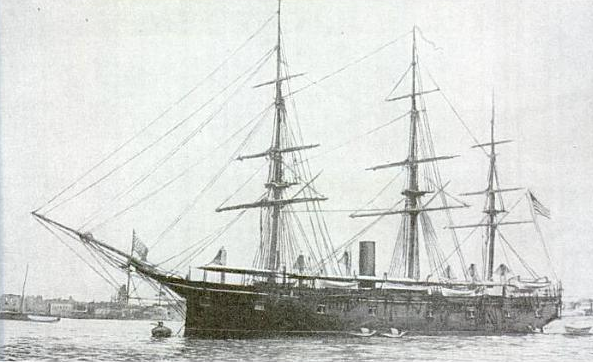
USS Trenton (1876), one of the rare, one-off “new navy” early frigates.
Basically the XIXth naval history of the US is rocky and interesting, especially for cruisers, which had their historic roots in Frigates. And the country-continent had its fair share of innovative development in this area. It starts the 1797 with the “super-frigates” ordered by the Congress, of which only one, the USS Constitution, aka ‘Old Ironsides’ is still with us today, veteran of the 1812 war and against the barbary corsairs.
Then it bounced again, as relations with the British Empire eased a bit, somewhat degraded the size of the US “old navy”, counting a few ships of the line and frigates, during the civil war. It forced the Union, to enforce its blockade to order a new generation of ships. The USN would pioneer the monitor and the submersible. The blockade was mostly the result of an armada of gunboats and sloops, but the Union had in mind a special class of ships designed for commerce raiding if Britain, somewhat supporting the south, went at war with USA. This was the Wampanoag class, on paper “Frigates” but classed by many authors as the first “cruisers” of the USN, in what was called then the “Old Navy” (see later).
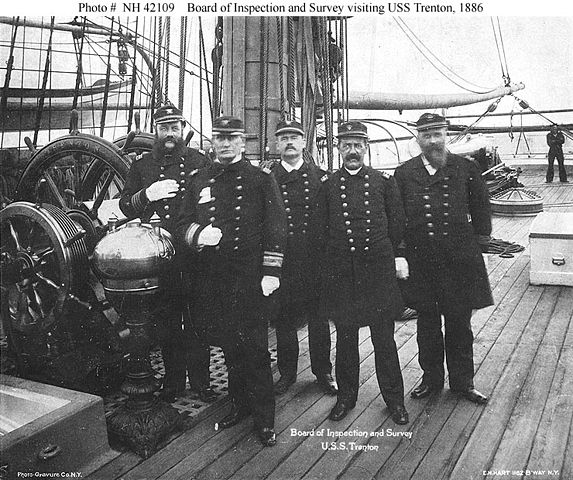
Admiral James Jouett on USS Trenton in 1886
The “New Navy” emerged gradually from the ashes of the civil war. Most of the Union fleet was deactivated and the continent stepped in isolation again. Outside 15 other Frigates and 10 screw sloops built in the 1860-70 decade, plus two experimental torpedo-rams, there was no significant other venture. It would take political will and influential writers such as Alfred T. Mahan for the US to gradually emerge from this isolationism and starting seeing itself more on ‘imperial’ terms, or at least taking the first step: Building a modern and strong Navy, which would soon take on one of the former European superpowers: Spain.
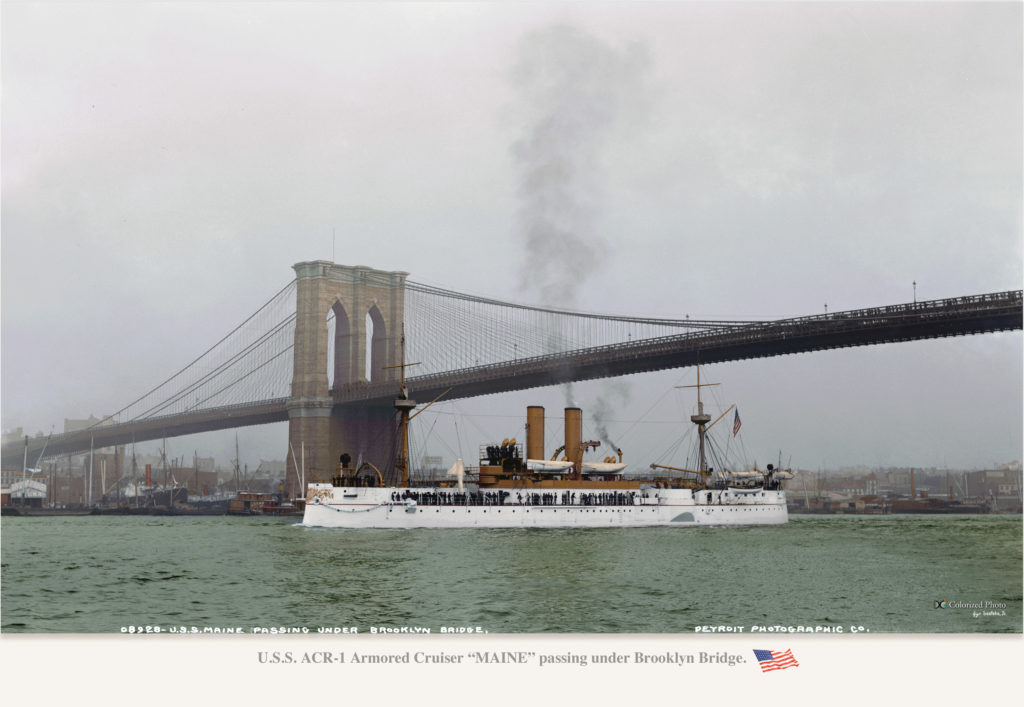
USS Maine (1889), coastal ironclad, soon reclassed as armoured cruiser (ACR1) – colorized by irootoko JR
Cruisers took a part of it: Before even the first battleship was built, USS Texas (laid down in 1889), and as the first modern Monitors were in (lengthy) construction since 1874-76, two cruisers were authorized and laid down in 1883, the Atlanta class. They formed the start of a lineage which is still active with the Ticonderoga class today.
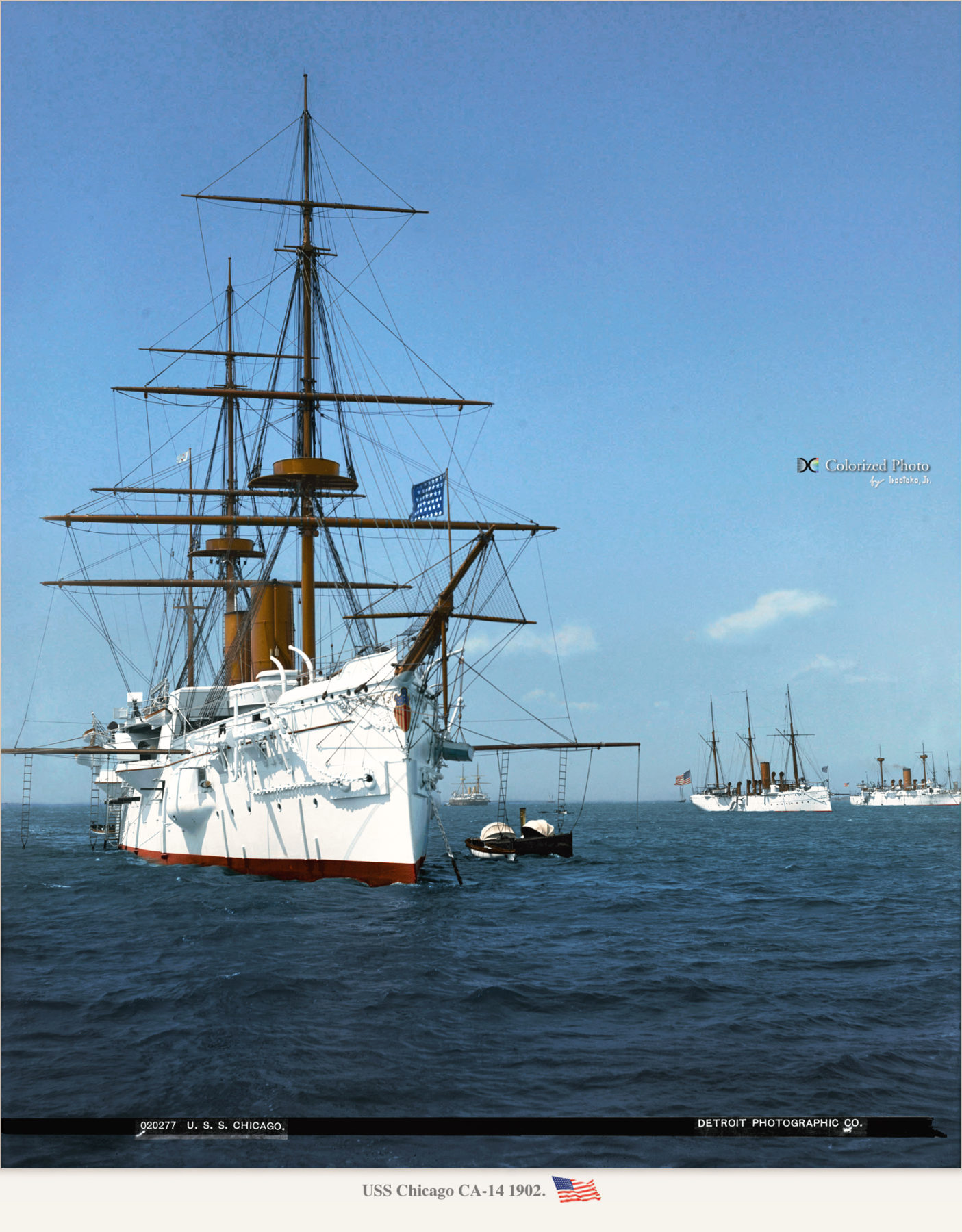
USS Chicago in 1902 – Colorized by Iroooko Jr.
Alongside these, two ships are noticeable, because they were classes retrospectively as experimental “cruisers” by default of a better classification. The first was the only “torpedo cruiser” ever built for the USN, USS Kathadin, and the other the only “dynamite-gun cruiser” ever built. In 1890 was laid down the first American armoured cruiser, and in 1905 were laid down at the same time the last armoured cruisers, and the last light cruiser (Chester class), before a true eclipse in Cruiser development, the dreadnought era.
Between fast dreadnoughts and larger fleet destroyers it was thought cruisers were now superfluous. And as amazing as it was, contrary to many other nations, the US Congress did not authorized (and the Admiralty did not wanted) a single cruiser until the end of WW1. Ten years of design vacancy, making the Marblehead class both the first and last American WW1 cruiser design and the earliest interwar cruiser design, also veterans of WW2.
Gradual evolution 1886-1920
Old Navy cruisers: Wampanoag to Contookok class
The first steam frigates appeared from 1842. By that time were in service the Fulton II (4 guns, 1837), USS Union (4 guns, testing an horizontal submerged paddle), USS Poinsett (2 guns, 1840) and the screw corvette Princeton. The first modern dedicated steam frigates were the USS Mississippi and Missouri, very large steam paddle frigates (1841,1842) of 3,220t, armed with 10 big Paixhans guns. Then came the Susquehanna and Powhatan (9 guns), USS San Jacinto and Saranac (6 guns) and ‘steamers first class’, USS Fulton, Michigan and Alleghany, plus Seven second class.
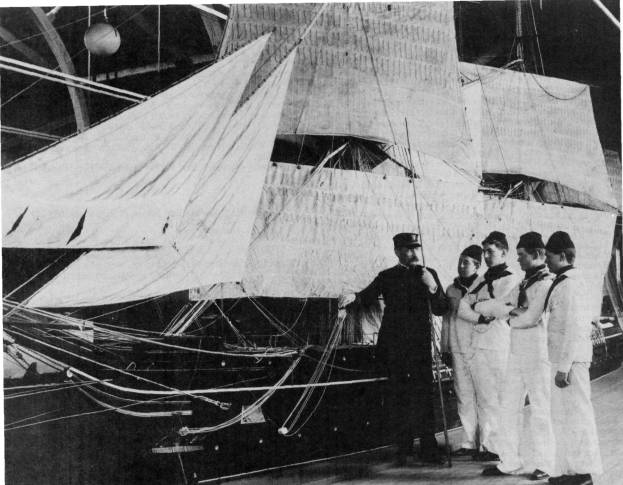
A very large model of USS Antienam shown to naval cadets
During the American civil war, commerce disruption by the Union against the Confederacy somewhat soured diplomatic relations with Europe, which imported goods from the southern states, and although not officially supporting the cause, accepted to build ships significant ships (such as the ironclad Stonewall Jackson). But in truth, Europeans came as observers (or volunteers) on both sides, and both diplomatic and business interests enforced neutrality. The Confederates for example had the conservative Bourbon branch Prince of Polignac whereas the Union saw the American branch of the Bonaparte serve their cause.
In case of war (notably Great Britain, which economy was the most effected by shortages from the south), the admiralty wanted ships tailored for oceanic, long range action, whereas the blockade until then concentrated efforts on more suitable gunboats, sloops, and monitors. European will to built ships for the Confederacy was not helping this state of relations, like the Commerce raiding campaign led by CSS Alabama and CSS Florida, both built in English yards. So the Congress authorized a serie of large, fast “super frigates” in the age of steam: The 4000 tonnes Wampanoag class. Authorized in 1863 and laid down that year they were launched in 1864-65 (one was cancelled, another never completed).
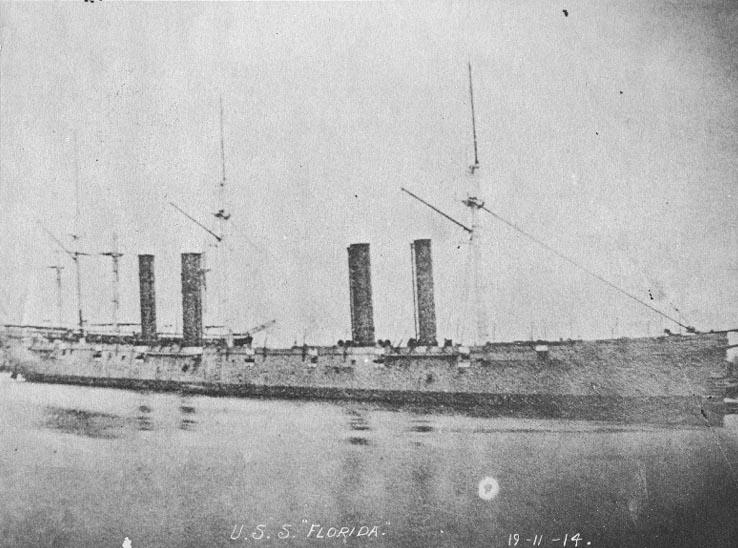
USS Florida, ex-Wampanoag as completed in the 1870s. These “cruisers” were designed for speed, by clipper ship architect Benjamin Franklin Delano.
Of the five planned only three entered service after the war: USS Wampanoag, Madawaska, and Ammonoosuc. Being built by different yards meant they differed considerably in tonnage, size, armament and powerplant. Nevertheless, their four funnels in two groups far apart and classic three-masted configuration with a straight bow made them quite unique. They were heavily armed with 15 heavy guns, some on pivots and others broadside, and can reach 17 knots, making them able to catch and destroyer any Confederate blockade runners. That’s why they are widely considered as the first “cruisers” of the USN, but they were modified after the war and eventually made their sea trials in 1868, being sold in 1883.
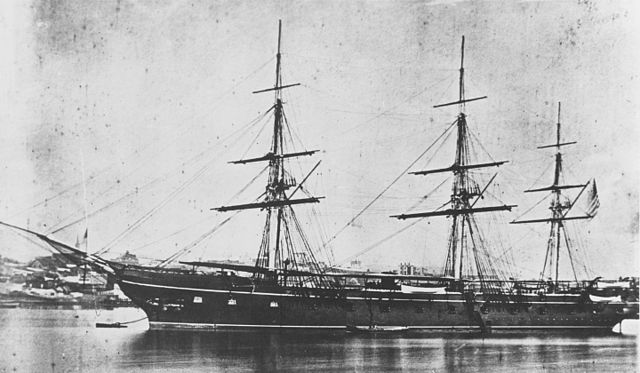
USS California, ex-Guerriere
At the same time, other wooden screw frigates were started, USS Chattanooga in Cramp, 1863 and USS Idaho at Georges Steers Yd in 1863, completed also after the war in 1866. Both were also commerce raider hunters, specified to be able to sustain 15 knots for 24 hours. Also laid down in 1863-64 was a “class” of homogeneous ships intended less for speed but sustained cruising at 12-13 knots: The Java class Frigates. The class comprised as ordered eight war vessels, of which only half were completed, again because the end of the war. They were the USS Antienam (completed as a sailing store ship in 1876), USS Guerriere, Minnetonka and Piscataqua. Other ships were broken up in 1872 or 1884.
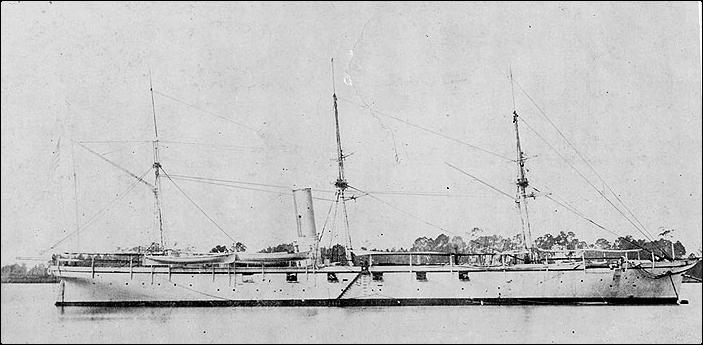
USS Contoocook.
At last, were order slightly smaller and more economical vessels, the Contoocook class. Laid down in late 1863 or 1864 they were launched after the war but completed and commissioned in 1868, 69 and 70. They were armed with a single 5.3 in parrot RL, fourteen broadside 9-in SB and three pivot 12-pdr guns, managing to reach more than 12 knots sustained. Their career was shot, ending in 1872 (Contoocook, renamed Albany 1869), 1877 (Mosholu, renamed Worcester 1869) and 1883 (Manitou, Pushmataha, renamed Severn and Cambridge). Six further ships named after Indian tribes were cancelled.
American oddities: Kathadin & Vesuvius
USS Kathadin
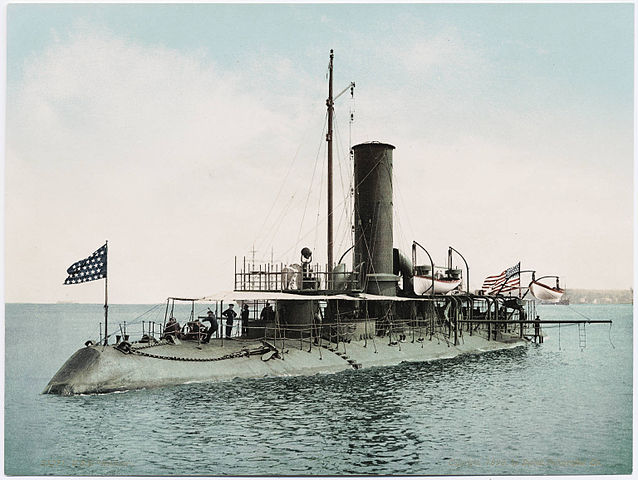
USS Kathadin was a torpedo-ram experiment, something tested already by the French (Taureau class) and British (Polyphemus class) and already experimented during the civil war (css Stonewall jackson, css manassas, uss keokuk). The idea was to create a steam ram, armoured, with some self-defence light guns but no torpedo tubes. The idea was pushed forward by Rear Admiral Daniel Ammen, and advocate for a smaller, coastal navy. USS Kathadin displaced 2200-2390 tonnes and could reach 16 knots thanks to a 2-shafts HTE steam engine. Her turtleback hull was covered with Harvey and nickel steel plates up to 6-inches in thickness.
The USS Kathadin was probably the shortest commissioned US Navy warship ever. She was commissioned in February 1897, just in time for the Spanish American war, in which she played no role: Indeed she was an experimental vessel, and as soon as her tests were completed, she was decommissioned, then recommissioned again to patrol the Atlantic coast in case of a retaliatory attack by the armada. She was decommissioned definitively on 8 October 1898 (so for 15 months) but her fate is uncertain from that point. She was stricken in 1909 and sunk as target.
USS Vesuvius
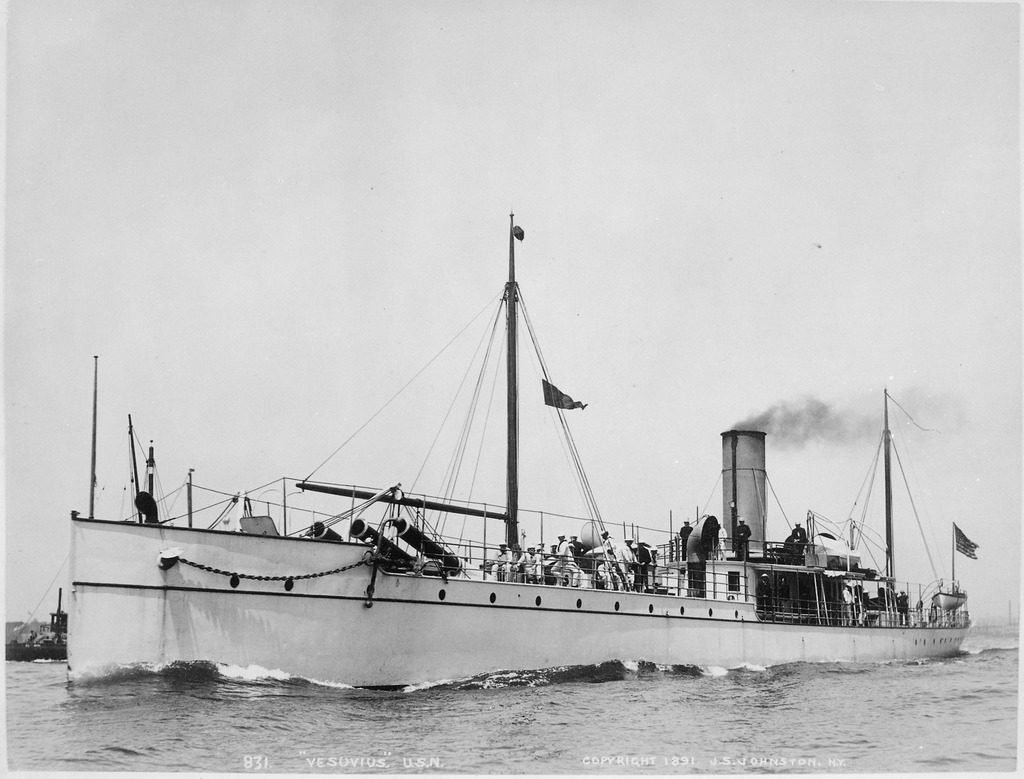
The “dynamite gun cruiser” was a very unique idea developed in the USN: The guns were pneumatic ones. These 15-inch (38-cm) cast iron pneumatic guns invented by D. M. Medford and developed by US Army officer (ret.) Edmund Zalinski, could fire 550-lbs high explosive shells at targets up to a mile away. They were stationed in fixed positions emerging from the deck because of their lenght. For traverse indeed, the whole ship needed to be turned to the right position.
The rest of the 930 long tons (945 t), 246 ft 3 in (75.06 m) long ship was not unarmed, there were three 3-pounder guns.
USS Vesuvius was propelled by two 2,183 hp (1,628 kW) 4-cylinder triple-expansion steam engines, and was able to reach 21 knots as designed.
The projectiles fired by the guns had brass casings 7 feet (2 meters) long with the explosive contained in the conical forward part. It was completed by spiral vanes on the after part to rotate it. To handle the projectiles with ease, they used desensitized blasting gelatin composed of nitrocellulose and nitroglycerin, reatively stable, but not enough as to force the use of compressed air rather than classic powder. Explove power was considerable as the “useful load” was 550 pounds (250 kg).
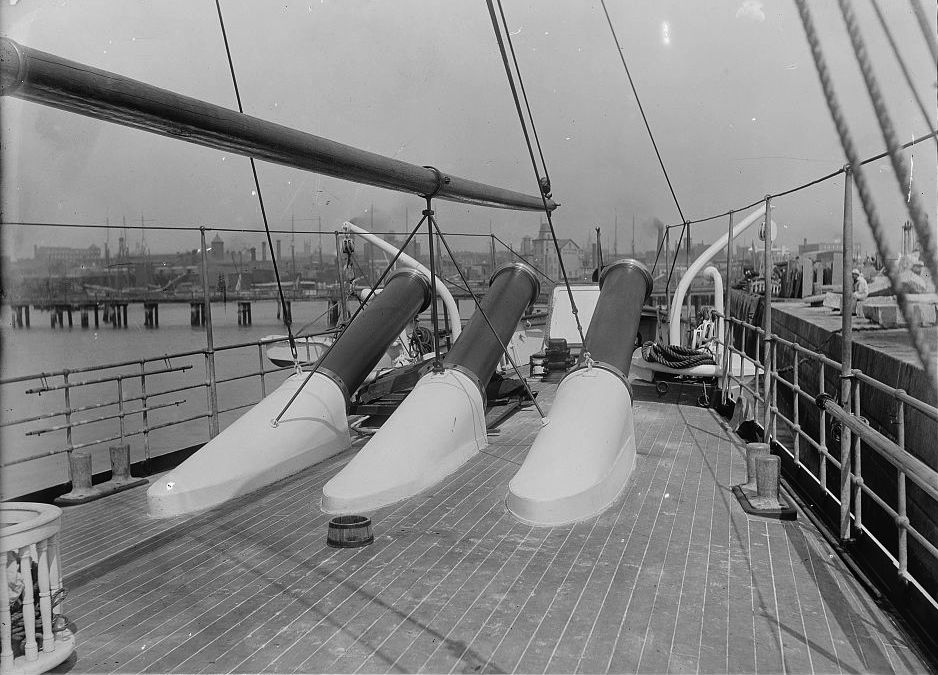
Compared to a classic gun, muzzle velocity was not precisely superfast at 800 feet (250 meters) per second. Range was comprised between 1.6 km with the full projectile and up to 4000 yards (3.7 km) with the ‘lightened’ 100 kgs (200 pounds) charge. Ten shells were stored on board, and 15 shells could be fired in 16 minutes 50 seconds as shown by a 1889 test. The detonation could be setup by and electrical fuze to explode underwater or any structure or burst in the air.
USS Vesuvius made a shakedown cruise and actively served during the Spanish-American War in 1898 to bombard enemy emplacements in Cuba. The guns being silent as for their working system, the enemy became unnerved because of their inability to hear any boom preceding incoming fire. Therefore they could not locate their point of origin and order a counter-battery fire.Despite their early success the whole dynamite guns concept quickly fell out of favor due to its lack of accuracy and high maintenance needs.
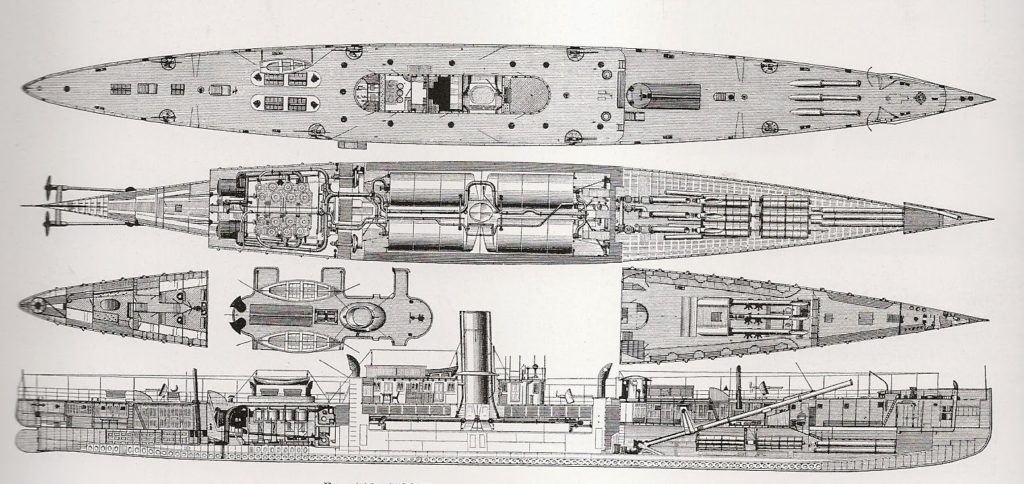
Ultimately after Vesuvius joined the Boston Navy Yard until 1904, the dynamite guns were removed and replaced with torpedo tubes and she was rebranded as a torpedo-testing vessel. Ultimately she was re-equiped with four torpedo tubes, including three 18 inch (450 mm) and one 21-inch. She was recommissioned on 21 June 1905 and served at the Rhode Island base, Naval Torpedo Station island. In May 1915, she suffered the indignity of almost sinking herself when one of her torpedoes circled back and slammed into the hull. Her captain made her running aground on Prudence Island in Narragansett Bay to avoid sinking. She was later repaired and stayed in reduced service until 1921 as station ship, sold in 1922 for BU.
Armaments
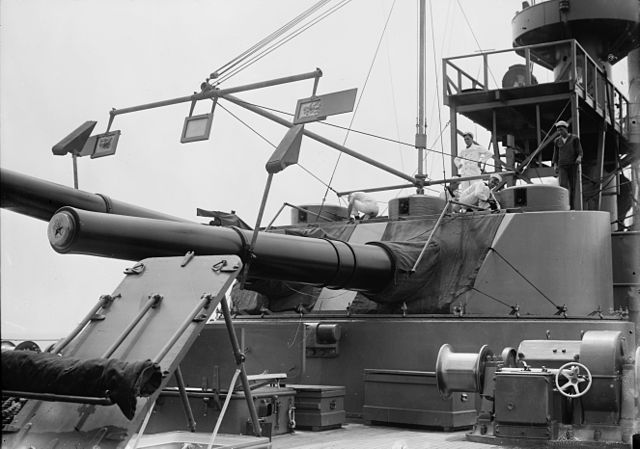
USS Seattle forward turret
Main Artillery
-10 in/30 (254 mm): USS Maine
-10 in/40 (254 mm): Tennessee class
-8 in/30 (203 mm): Atlanta, Chicago, Newark.
-8 in/35 (203 mm): Charleston, Baltimore, Olympia, New York, Brooklyn
-8 in/40 (203 mm): Pennsylvania, Columbia
-6 in/30 (152 mm): Philadelphia, San Francisco
-6 in/40 (152 mm): Cincinnati
-6 in/50 (152 mm): New Orleans
-6 in/53 (152 mm): Omaha class
-5 in/50 (127 mm): Denver, Chester, St Louis
Secondary Artillery
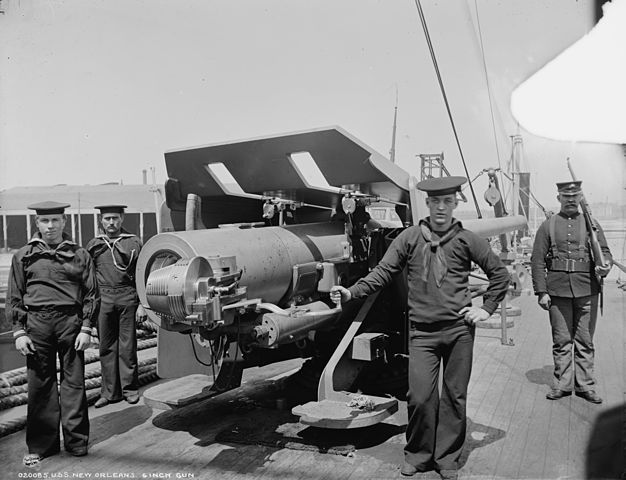
US-manufactured 6-inches masked gun onboard USS New Orleans
Some guns were actually used a primary guns are well, or their caliber were close to main guns.
-6 in/30/35 (152 mm): Atlanta, Chicago, Charleston, Baltimore
-6 in/50 (152 mm): Pennsylvania, Tennessee
-5 in/50 (127 mm): Brooklyn, Olympia, Cincinnati
-4.7 in/50 (120 mm): New Orleans
-4 in/40 (110 mm): New York
Tertiary Artillery
Real tertiaries were dedicated anti-torpedo boat, quick firing models. With the “new navy” were introduced 1, 3 and 6-pdr guns, 37 mm (1.46″), 47 mm (1.85″) and 57 mm (2.24″), also found in the Royal Navy as a standard and many navies around the world. The early models were purchased from the French-American Hotchkiss company. They were introduced in the 1880s and later models were manufactured by Driggs-Schroeder in the US. They were made obsolete because of rapid progress of torpedo boats, necessitating larger-caliber guns, which led to the development of the ubiquitous 76 mm or 3-in and its AA version. When WW1 broke out, only three classes of cruisers used the 3-in/50, and the wartime Omaha class were the first to introduce an anti-aircraft variant.
-3in/50 & 3in/50 AA (76 mm): Chester, Pennsylvania, Sy Louis, Tennessee, Omaha
-6 pdr/57 mm or 2.2 in: All but Chester and Omaha classes
-3 pdr/47 mm or 1.8 in: Atlanta, Newark, Charleston, Philadelphia, San Francisco,
-1 pdr/37 mm or 1.5 in: All ships but Chester and Omaha
Torpedo Tubes:
Note: No torpedo tubes on cruisers before USS Olympia. 18-in for all cruisers but the last armoured cruisers and scout cruisers. USS Minneapolis was the only one ever fitted with small 14-in tubes as an experiment. The tubes were always above the waterline to the exception of the Chester class and the large armoured cruisers of the Pennsylvania and Tennessee class (submerged). These were broadside, fixed tubes. The Omaha class were the first to introduce traversable deck banks like destroyers, two triple and two twin.
-14 in/356 mm: Minneapolis
-18 in/457 mm: New Orleans, Mongomery, Cincinatti, Olympia, Columbia, New York, Brooklyn, Pennsylvania
-21 in/533 mm: Tennessee, Chester, Omaha.
Doctrine & Operations
The Spanish American War of 1898
The first serious test for “new navy” cruisers happened at the occasion of the Spanish American war of 1898. On paper, both for cruisers and capital ships, the USN was inferior to the Armada. However the admiralty planned to attack Spanish colonial possessions, not the metropolis. Were present during this conflict the only two capital ships of the Navy, USS Texas (USS Maine blew up in Havana, giving the casus belli needed), the Indiana class battleships USS Oregon and the unique USS Iowa, fresh from commissioning. But due to the speed needed for operations and distance, cruisers made the bulk of the operations, with gunboats, although many stayed on the Western cost to prevent an attack of the metropolitan Armada through the Atlantic.

USS New York in 1898
Probably the most famous ships to participate were USS New York, first USN armoured cruiser and flagship of Rear-Admiral Sampson at Santiago de Cuba, together with USS Brooklyn, flagship of Commodore Schley, and USS Olympia, flagship of Commodore Dewey at Manila. The latter was a protected cruiser. The first battle was not in Cuba, but an attempt of a diversionary attack, to try to lure out the Spanish Navy in the Pacific before striking in Cuba. The USN attack at Manilla, the other large colonial possession of the Spanish Empire, the Philippines, took place on 1st May 1898. The attack came as a surprise as the local forces were ill-prepared, staying under the protection of coastal artillery, and their crews were not fit for the ferocity of the assault.
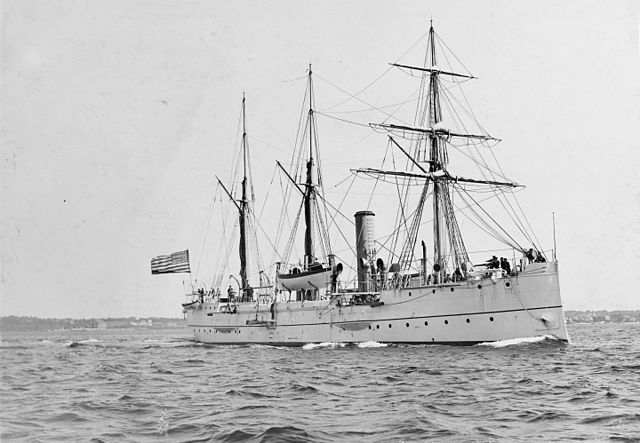
USS Petrel. USN Gunboats played a great part in 1898 battles, in size and armament they were considered almost as second-class cruisers. The 1888 Yorktown class for example displaced almost 2000 tonnes and had six 6-in guns.
“Battleline exercise” at Manila
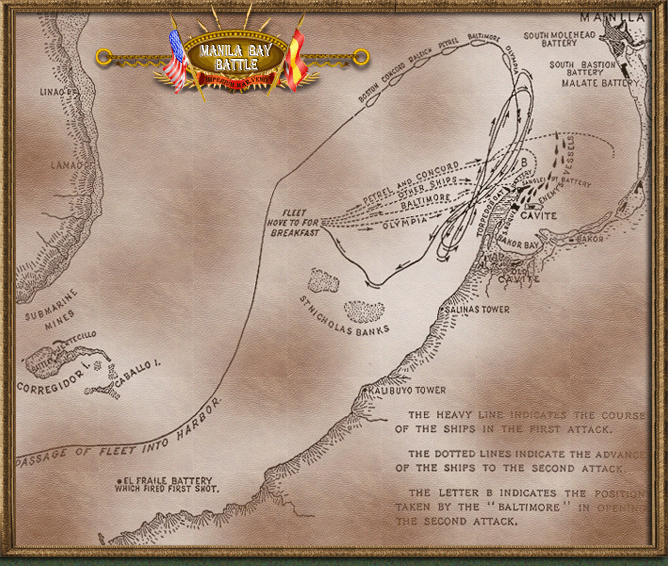
This was a daylight raid of a USN squadron against the Spanish Pacific Fleet anchored at Manila Bay. Dewey’s plan was daring, hazardous and risky, but succeeded beyond any hopes. Dewey was in Hong Kong when he was promoted to the Pacific squadron by Teddy Roosevelt, and his motley fleet was composed of the USS Olympia and the USS Boston, both protected cruisers, the gunboat USS Petrel and the very old steam paddle USS Monocacy. With this small force, he was supposed to destroy the Spanish naval force in the Philippines, much larger on paper. One of his headaches has been coal supply. His small fleet crossed the distance with a small force of coal ships, and was reinforced before the battle with another cruiser, USS Raleigh, and the small custom boat USS Mc Cullogh and gunboat USS Concord just before departing.
At Manila they faced a force led by Admiral Don Patricio y Montojo Pasaron, with the cruisers Don Antonio de Ulloa, Don Juan de Austria, Reina Cristina, Castilla, Isla de Cuba, Isla de Luzon, and the gunboat Marques del Duero. On paper, this was six cruisers versus Dewey’s only four, however most Spanish cruisers were obsolete and small, almost gunboat-size. Two were later captured and pressed in USN service as such. In addition, decision was taken to remove guns from Don Antonio, General Lezo and from the cruiser Velasco, to install them in fortifications. Montojo awaited the Americans, which had been spotted already on their way, but did not knew the time. He eventually decided not to risk his fleet at sea, and have it half-sunk by using pumps, just under fortified Sangley Point, and the battery of Ulloa on Cavite.
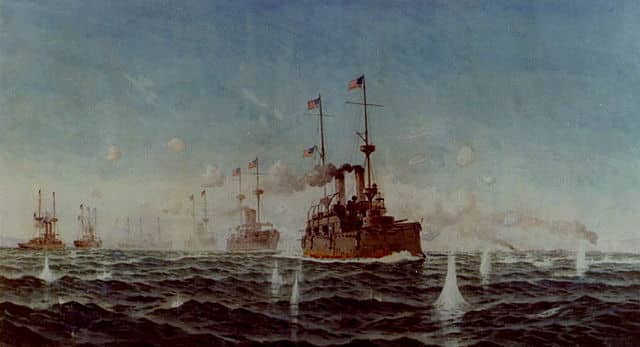
USS Olympia leading the line
Dewey gathered and prepared his forces in Luzon, before entering Subic Bay; His line comprised, in order, USS Olympia, USS Nanshan (transport steamer), Zafiro (captured steamer), McCulloch, Petrel, while USS Raleigh, Concord and Boston closed the line. Basically his battle line made a great sweep before the Spanish ships, without Zafiro, the Nanshan and McCulloch which were unarmed and stayed behind. His line entered Cavite, spotted the Spanish line and opened fire at dawn (it was 5 AM), first on Spanish batteries, sparing their ammo for the ships later. He opened fire on the ships about 30 min. later, manoeuvring his line into a loop and retiring for lunch at 7:30 AM. During the whole operation, Dewey’s line was slow, about 3 knots, and ordered were given to gunners to take their time for perfect aiming.
Artistic, dramatic rendition of the battle of Manila (Subic Bay). The artist made it look like the fight was point-blank range, but in reality distances were of around 2000 yards (1.8 km), which was still close, eve, by the standards of the time. At Yalu, four years before, distances were comparable. This peaks volumes about accuracy as only 2% of the shells actually hit.
He went back for a second swoop, doing the same manoeuvre to “finish off” the Spanish ships ad Montojo decided later to scuttle his ships and evacuate the crews. His forces will later surrender. On the USN side, only USS Baltimore had some light damage by a ricocheting shell that did not exploded, causing 8 minor injuries as a result of sparks and splinters. Talking of ‘doctrine’, Dewey simply applied a textbook battle line tactic, preferring to engage first coastal batteries, more a threat to his eyes, before broadsiding Montojo’s squadron, taking each ship in turn. Almost showing contempt for the Spaniards, he almost acted as in a peacetime exercise. On their side the latter had partly disarmed ships not in shape for sea going action, Hontoria guns that were worn out, limited supplies of ammo that were defectious in part, lack of maintenance, and crucially, lack of training for the crews, deprived or firing exercises for long.
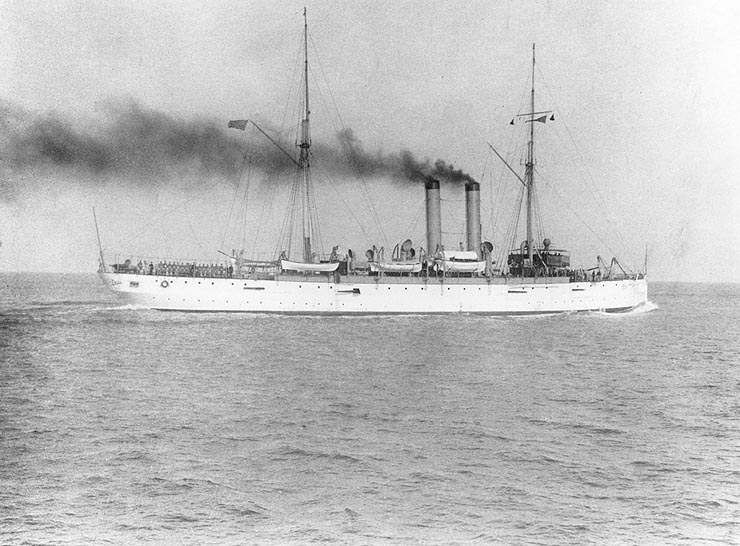
USS Denver underway, one of the six “gunboat cruiser” ordered after the war to watch over Cuban and Philippine ‘protectorates’
Ranges had been short, but the Spaniard almost scored no hit, whereas the USN squadron had only 2% hits, which were sufficient to disable most ships. Dewey swung in front of the Spanish ships and forts in line ahead, firing port guns, then turned and passed back with starboard guns and the process was repeated five times, with a range going from 5,000 yards down to 2,000 yards. It’s still amazing that no fort or ship on the Spanish side had any significant hit, for two hours and a half. In any case, this first naval engagement since the civil war gave tremendous confidence to the US Navy.
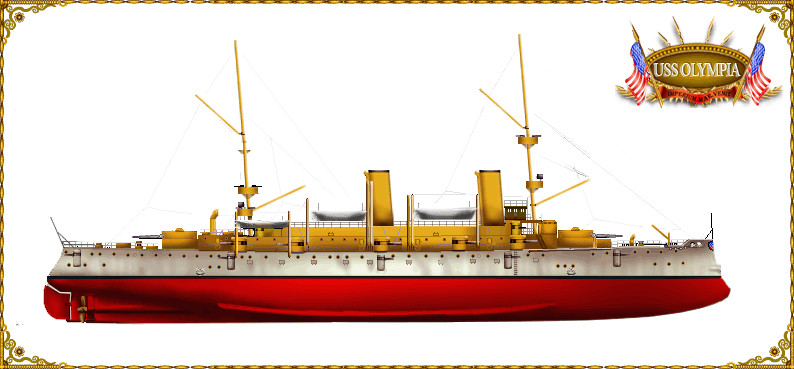
Dewey’s USS Olympia is now preserved and the best and only example of a 1890s armoured cruiser (Author’s illustration).
Blockade “turkey shoot” at Santiago (July, 3, 1898)
Closer to home, the USN squadron that blockaded the Spanish fleet at Santiago de Cuba was much larger than Dewey’s Pacific squadron. Sampson’s blockading fleet comprised four battleships (Texas, Oregon, Iowa, Indiana), 2 armored cruisers (Brooklyn, New York) and two armed yachts. Opposing him, Admiral Cervera came from Spain, assemblng a squadron at the Cape Verde islands, comprising the armoured cruisers Vizcaya, Infanta Maria Teresa, Cristobal Colon, the destroyers Furor, Terror and Pluto, sent to relieve the small force of Cuba (led by the flagship Almirante Ocquendo). On paper, the Spanish cruisers were relatively modern and worthy adversaries. However against USN battleships that was anoher story. However in that case, USN Battleships played little role due to their slower speed, which was a essentially a chasing engagement, even the “bulldog of the fleet”, USS Oregon. This was the battle of Santiago de Cuba.
Cervera initial plan, that he proposed to Madrid, was to link up with another squadron from Cartagena at the Canary Islands, taking the advancing USN fleet in a pincer. However he was ordered to sail to Cuba as soon as possible to engage the enemy, to his dismay. Indeed his fleet had problems, they had a poor supply of shells, guns breech blocks issues, a general lack of maintenance, notably no fooling, making the ships slower such as Vizcaya (12 knots max), or freshly delivered Cristobal Colon, which missed her main guns. Having his fleet assembled at Santiago was judicious to his eyes, as the harbour was generously dotted with coastal fortifications. There was some initial confusion between Schley and Sampson over the real location of the Spanish fleet. The former was adamant Cervera was in Cienfuegos. But eventually Cervera’s fleet was spotted by Cuban insurgents, and communication went to Schley, which made a coaling before departing.
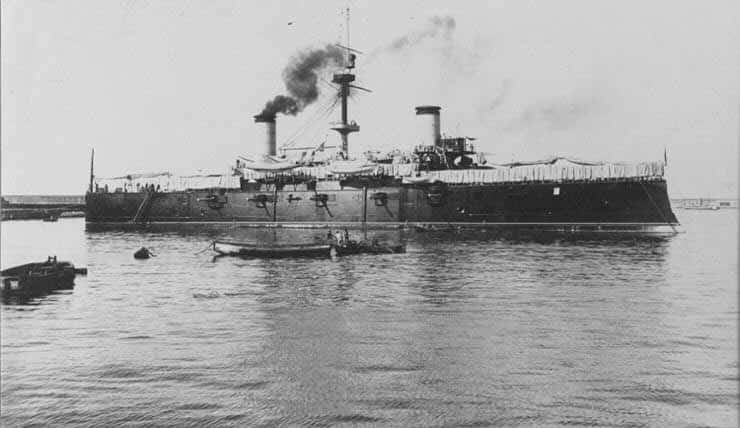
Cristobal Colon, probably the best armoured cruiser of Cervera, one of the Garibaldi-class ships.
Cervera was ordered to leave the bay of Santiago on July 3, at 9:00, and was spotted first by watchmen of USS Brooklyn. Amazingly, the USN was so confident in the result of the engagement that many civilian yachts and schooners were also waiting around to make a picnic, waiting for the event. USS New York however (Sampson) was no longer on sight and missed the information. Meanwhile, USS Iowa engaged Maria Teresa, which was badly damaged as expected. Sampson at least realizing Cervera’s squadron was off, trying to run the blockade, he ordered his ship back, trying to “close the T”, a classic manoeuvers to disable with his broadsides each arriving Spanish ship. Cervera decided to make a diversion, charging with his cruiser USS Brooklyn as for a ramming, allowing the rest of the fleet to escape due east. Brooklyn was forced to manoeuver and nearly collided with USS Texas.
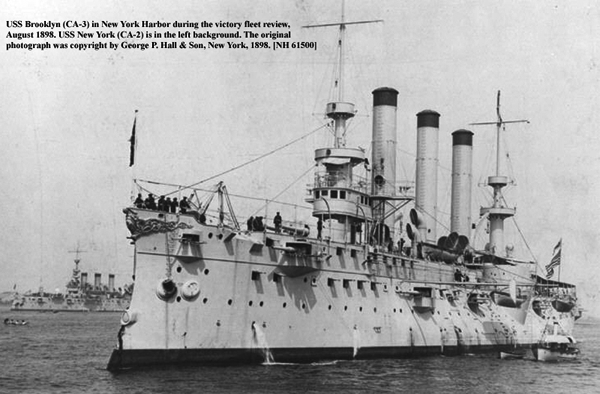
After the crippled Maria Teresa, Almirante Ocquendo was next indeed. Crippled, she eventually ran aground and exploded; Furor, Terror, followed by Pluto were chased by the fleet, and the first (with his inventor, Villaamil on board) had its ruder jammed and was sunk rapidly. Next, USS Brooklyn, Texas and Oregon chased the armoured cruiser Vizcaya. The latter had two 11-in (280 mm) guns, which proved a threat. But theor only lucky hit on USS Brooklyn was a dud. Vizcaya would end as a burning wreck on the coast. The last Spanish cruiser, Colon, was chased by Brooklyn and Oregon behind. She was the most recent and therefore fastest, and seemed to put distance, however the coast was forcing to turn, and as coal was getting low, stokers had to use low-quality coal. The ship was more visible due to the hevy smoke and slower. Eventually she was caught and finished off by USS Oregon. USS New York was too far away to do any damage. So in the end, only USS Brooklyn had the occasion to prove her metal. The battle was more a chasing execution by battleships than any useful manoeuver scheme for cruisers.
US Cruisers of WWI
When WW1 broke out, the US Navy was caught with an ongoing program for more dreadnoughts, always larger and better armed, but no cruiser. There has been a program in 1915, not authorized, by C&R to design “scouts” as complementary to fleet destroyers but with a longer range. The vacancy since 1904 caused the US Navy to enter the war with a fleet of cruisers 10 to 15 years old and way more. In fact compared to its battleship fleet, the cruiser fleet was certainly not up to the task.
US Navy early “new navy” collection of masted cruisers of the 1880-1890s has been relegated to secondary duties, which left the fleet with choices to make, based on speed, mostly. The 2000-3000 tonnes protected cruisers of the Cincinnati and Montgomery, and Denver classes formed the bulk of “recent” serviceable cruisers that can 16 to 19 knots. Cincinatti and Raleigh operated along the north-south american coast. Montgomery, Detroit and Marblehead made coastal patrols and training missions. They stayed home, notably because of their range, safeguarding ports and home waters and the western atlantic. The slow Denver (16 knots) were also called “peace cruisers” and were effectively used as gunboats. USS Denver escorted eight convoys til mid-ocean, as Des Moines, Chattanooga, also from the summer of 1917, as Galveston and Tacoma. The latter was badly damaged in Halifax during the explosion of Mont Blanc.
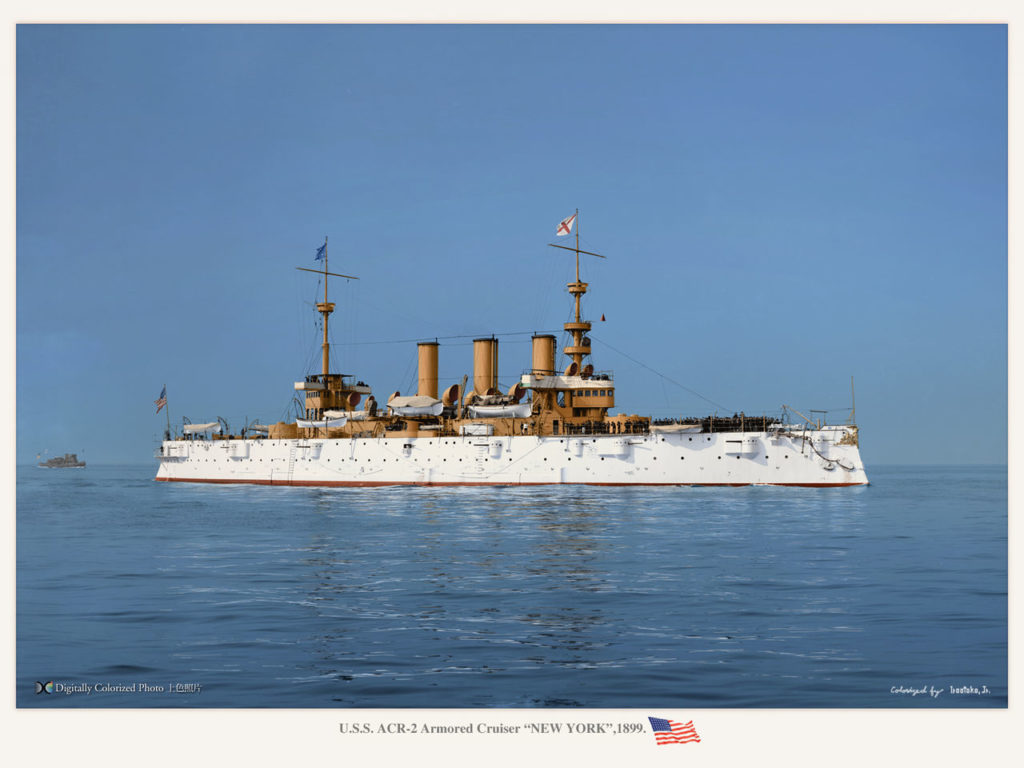
USS New York, colorized by Irootoko jr. Notice the typical peacetime livery for the Caribbean, white hull, canvas beige for the superstructure. The prow showed the US official heraldry figure. From 1916 or before they were painted medium navy grey. In fact the USN tried light gray and medium gray paint schemes already in 1898. Artist Abbott Handerson Thayer investigated countershading color schemes but the navy switched from gray to white in the 1900s for the famous “great white fleet”, and back to Medium Grey again after their return in 1908.
The Colombia and New Orleans classes were capable of 20-21 knots and certainly more active. Both the Columbia and Minneapolis served as convoy escort ships and went to the Pacific after the war was over. The New Orleans were British-built typical Elwick cruisers, purchased from an aborted sell to the Brazilians. USS Albany was flagship for Squadron 6, Patrol Force, Atlantic Fleet, making convoy escort during the war, and moved in 1919 to give support to the whites during the Russian civil war. USS New Orleans also escorted convoys, from New York City to ocean rendezvous with destroyer escorts off the British Isles, making the liaison with French coast until 16 January 1918. She was sent in the Pacific afterwards.
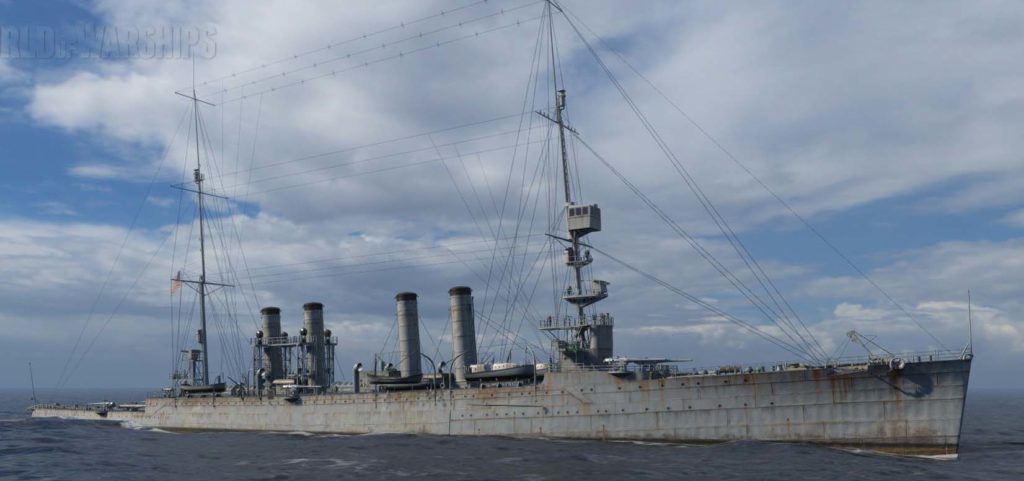
Wow- Whatif-rendition of USS Phoenix – An alleged early proposal for the scout cruiser of the Omaha class design. Was it real ? The name is totally fake, inspired by the following serie of cities, and is allegedly inspired by a successor design for the Chester class in 1917. They were definitely scouts, acting as “eyes” of the fleet as well as flotilla leaders. This was the “scout 1917 program”, the congress refused to vote because of its cost and fear it would be obsolete at completion. The congress revised its opinion the next year when voting the Omaha-class, actually going back to the 1916 naval program. According to Conway’s, this could well be the alternative 5,000 tonnes design proposed by C&R in 1917. The project was dropped because the heavy armament did not match shipbuilding realities on this displacement, combining a top speed of 35 knots.
There was also the valuable USN 20 knots+ armoured cruiser fleet: Sixteen heavily armed warships, in the 8,500-14,500 tonnes range in displacement. They were the old Cuban veterans, USS New York and Brooklyn, the six Pennsylvania class, three St Louis class and Five Tennesse class. The later were well protected, large, with nealry 2000 tonnes of coal capacity. They were able to escort convoys to the mid-Atlantic and well beyond.
USS New York became USS Rochester on 1 December 1917, and was part of the Atlantic fleet escort force, making three trips and then more to repatriate troops. USS Brooklyn was a receiving ship in Boston NyD when the war broke out, Atlantic Reserve Fleet. After Neutrality Patrols, she was sent in the Pacific.
USS St Louis was in escort of Group 4, American Expeditionary Force for escort duties, coast to coast. Milwaukee was stranded and a written off in 1917 while USS Charleston carried and escorted the American Expeditionary Force to France NYC to Saint Nazaire (five missions), repatriating veterans.
The Pennsylvania class were all renamed before the war broke out, from 1912 to 1916, even 1920 for USS South Dakota. These large cruisers were transferred to convoy escort duty in the North Atlantic. USS Pittsburg was in the Pacific chasing (without success) for German commerce raiders. USS Huntington operated an observation balloon to try to spot submerged U-Boats. USS San Diego became the only US Armoured Cruiser sank due to wartime operations: She hit a mine off Fire Island, New York, probably laid by U-156, or by a torpedo (Conways).
The Tennessee class were also renamed 1916 to 1920 and had a similar career during these short wartime operations. USS Tennesse was wrecked in August 1916 after a Tsunami and never recovered. The others, Memphis, Seattle, Charlotte and Missoula. USS Seattle experimented with observation seaplanes, having four of these and two catapults. She also served as flagship of the Destroyer Force and escort for the first American convoy to European waters. USS North Carolina (later Charlotte) became the first ship ever to launch an aircraft by catapult, on 5 September 1915.
Perhaps the “best card” of the USN in 1917 were the Chester class scouts. The 24-knots cruisers were the only true “scouts” of the navy and had quite an active career in 1917-18. All these cruisers were doomed by the signature of the Washington naval treaty. The tonnage ban concerning cruisers forced most of theme to be retired, sold in 1930 after a long reserve period, altough the carrier of a few went on until WW2 under various roles or simply were still extant after 50-60 years. Such was the case for:
-USS Despatch (ex-Atlanta), the doyen of USN cruisers, receiving ship at Yerba Buena until 1946.
-USS Baltimore was decomm. since 1922 and rested in Pearl Harbor. She was sold in 1942 as scrap metal.
-USS Olympia, preserved as a veteran of the Philippines in 1898 to this day, museum ship in Philadelphia.
-USS Yosemite (ex-San Francisco) decomm. 1921, was stricken since 1930 but sold in 1939 in Philadelphia.
-USS Rochester (ex-Saratoga, ex-New York), decomm. since 1933, receiving ship at Olomgapo, Philippines, scuttled to avoid capture by the Japanese in December 1941.
-USS Seattle, receiving ship in NyC until 1941, renamed IX39 as a misc. auxiliary and sold in 1946.
Of course, none of the Omaha class scout cruisers, laid down in December 1918 for the first two, seen anything of WW1. But they fully participated in WW2 in active roles and all survived, to be striken in 1945-46.
Sailing cruisers 1886-1898
USS Atlanta class
USS Atlanta, USS Boston
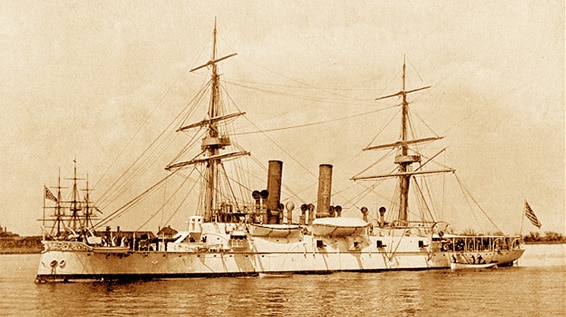
Authorized by the Congress in 1883, this was the first modern USN cruiser and the whole lineage to the this day (Ticonderoga) came from there, a span of 100 years; These were wide but short ships displacing 3200 tonnes, armed with 8-in guns fore and aft in barbettes and behind masks, with two masts and square rigging, clipper stern and ram, low freeboard. Light artillery comprised six 6-in guns, two 6-pdr, two 3-pdr and two 1-pdr. They were propelled at 13 knots with a single shaft HC engine with an output of 3500 ihp, carryong around 380 tonnes of coal. Both were unprotected cruisers.
USS Atlanta and Boston were built in John Roach Yard but fitted out in New York, launched in the fall of 1884 and completed in 1886 and 1887. From November 1905 tlanta served as an accomodation ship for TB crews but was sold in 1912. Her sister ship USS Boston served as the training ship for the Oregon naval militia from 1911 to 1916 and then receiving ship at Yerba Buena, from 1918 to 1946, renamed USS Despatch in between in 1940.
Specifications
Displacement: 3189t
Dimensions: 86.26 x 12,80 x 5.18m
Propulsion: 1 shaft HTE, 8 cyl boilers, 3500 shp. 13 knots.
Crew: 284
Armament: 2x 8-in, 6 x 6-in, 2x 6-pdr, 3-pdr 1-pdr
USS Chicago
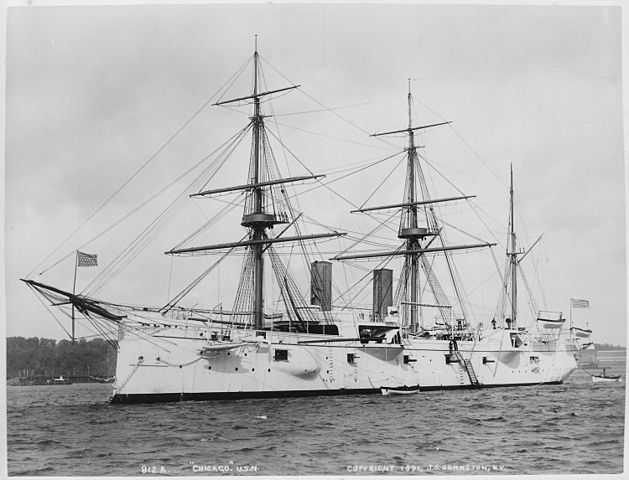
Auhorized also in 1883 by the Congress this unprotected masted cruisers was way larger, intended for long range missions in distant stations. Only protection was a stray of 1-1/2 in deck extending on 136 feets over the machinery spaces and 3/4 inches above the machinery. Armament comprised now four 8-inches (203 mm) in upper deck sponsons amidships the fore pair abreast the foremast, and the aft pair between the main and aft masts. The rest were in side sponsons behind hull’s apertures and mixed 6-in and 5-in guns in addition to light artillery. She had no torpedo tubes. USS Chicago was rigged as a barque wihout royals and had a tall hull made for heavy weather, a stark contrast with the Atlanta class which sat very low on the water and were wet. USS Chicago also had a clipper stern and reasonably sloped ram. She carried almost double coal compared to the Atlanta, for a much greater range and used a Compound engine of the COB type on two shafts, speed was also better at 14 knots.
USS Chicago was launched at John Roach in December 1885 and completed in Delaware Yard, which purchased John Roach, in April 1889. On trials her machinery gave 5084 ihp for 15.4 knots. In 1895 she was taken in hands for reconstruction: 1-1/2 deck plating was added over the steering room, 1-in over the gun crews, 1-1/8 in on 70 feets to reinforce the bow. The conning tower received 3-in walls (76 mm). At the same time her armament was upgraded with 8-in/35 main guns instead of 30 calibers, while the 6-in and 5-in were diposedof and replaced by a battery of fourteen 5-in/40 guns. The machinery was upgraded with six Babcock and wilcox boilers feeding four new HTE steam engines, 9000 ihp total, top speed of 18 knots while the masts were lightened and simplified, rigging eliminated.
In 1910-1917 USS Chicago was relegated as training ship for the Massachusetts and Pennsylvania naval militias. Later she was a receiving ship for submarines until 1923 while her armament was cut down to four 5-in, named USS CA14. She was transferred to Pearl Harbor as accomodation ship until 1935 as USS Alton, discarded and sold for BU but lost when she was towed en route in July 1936.
Specifications (1892)
Displacement: 4500/4864t
Dimensions: 104.39 x 14,7 x 5.79m
Propulsion 2 shafts, 6 Babcock et Wilcox boilers, 9000 shp. 18 knots.
Crew: 409-471
Armament: 4 x 8-in, 14 x 5-in, 2 x 1 pdr.
USS Newark
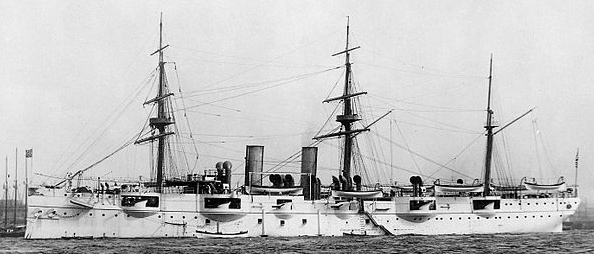
USS Newark was number C1, the first numbered in the USN, whereas she was already the eight “cruiser” of the USN. Authorized in 1885 she was laid down in 1888 in William Cramp & Sons, Philadelphia. She was quite an improvement over the Chicago, although she still shared many aspects with her; She was slightly shorter but wider, and was the first USN protected cruiser. Indeed since the beginning she was given a complete protective deck, 2 in thick turteleback with 3-in slopes, reduced to 2-in for the forward end but 3in aft to better protected the engine rooms and steering room. She also had four cylinders boilers feeding two HTE steam engines on two shafts, rated for 8500 ihp, providing 18 knots. She also carried 800 tonnes of coal in wartime.
Instead of a few heavy guns she had twelve quick-firing 6-in guns (152 mm)/30 caliber, in side sponsons lower in the hull to proved a better stability, in sponsons protected by shields, but protected by high walls and tops. In addition she had four 3-pdr and two 1-pdr placed high up in the fighting tops. USS Newark was rigged as a barque withour royals, also with two raked funnels, so she still looked like the Chicago.
USS Newark was completed at Cramp in 1891, commissioned and rearmed in 1902 by new 40 caliber, faster 6-in guns, and her rigging was removed. In 1913, june, she was stricken from the navy list, and renamed quarantine hulk R1 at Providence and later hospital annex. She was sold in 1926.
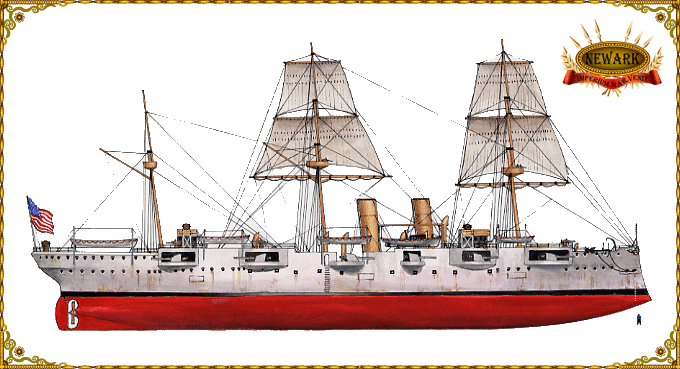
Author’s illustration of USS Newark as built.
Specifications
Displacement: 4083/4952 t
Dimensions: 99.97 x 14,98 x 5.74m
Propulsion 2 shafts HTE, 4 cyl Babcock et Wilcox boilers, 8500 shp. 18 knots.
Crew: 198
Armament: 12 x 6-in, 4 x 3pdr, 2 x 1 pdr.
USS Charleston
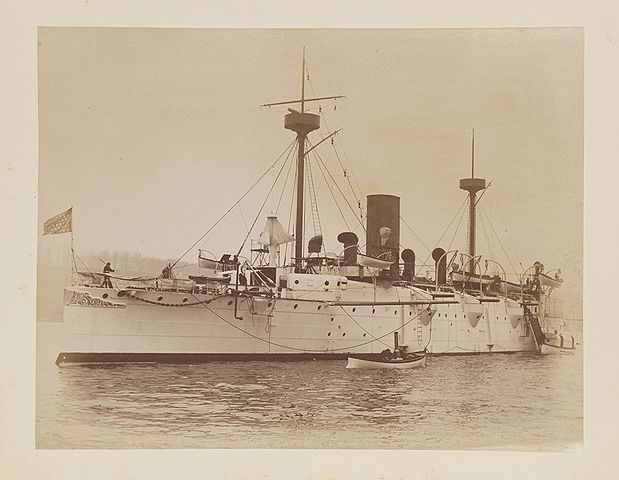
A bit forgotten, USS Charleston was the second protected cruiser (C2), also built in USA, at Unio iron Works, but on British plans from Elswick, inspired by IJN Naniwa, herself derived from the famous export cruiser Esmeralda designed in 1880 by naval architect George Wightwick Rendel, the successor of William Henry White. She had the 8-in guns fore and aft of the superstructure, a relatively low hull with a central shielding section, a single funnel and two short masts, no rigging. Her secondary armament comprised six 6-in/30 guns, two 3-pdr and two 1-pdr light guns but still no TT. The main guns barbettes had 2-in thick barbettes, like the CT walls and 2-in protective deck with 3-in slopes. Commissioned in December 1889 she had a short career, wercked on an uncharted rock in November 1899 off Camiguin island n the Phippines, demaged beyond repair.
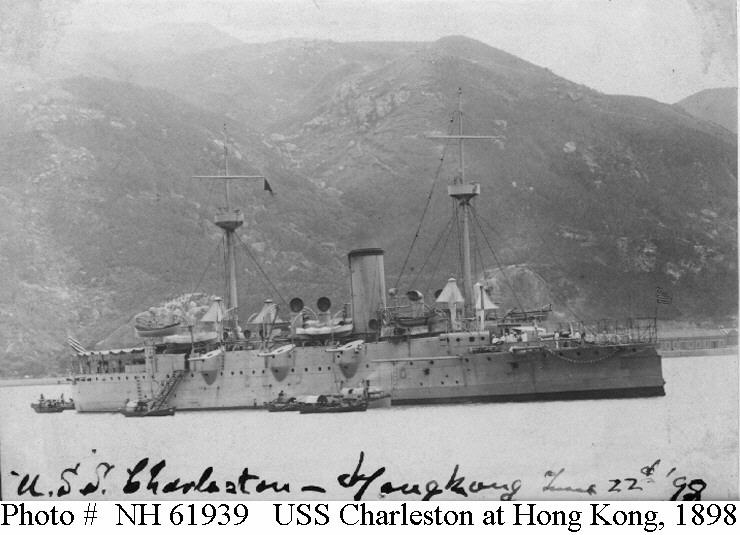
USS Charleston in Hong Kong
Specifications
Displacement: 370/4200t
Dimensions: 97.54 x 14,01 x 5.64m
Propulsion: 2 shafts HC, 6 cyl boilers, 7650 shp. 18.9 knots
Crew: 300
Armament: 2 x 8in, 6 x 6in, 4 x 6pdr, 2 x 3pdr, 2 x 1pdr.
Baltimore class cruisers
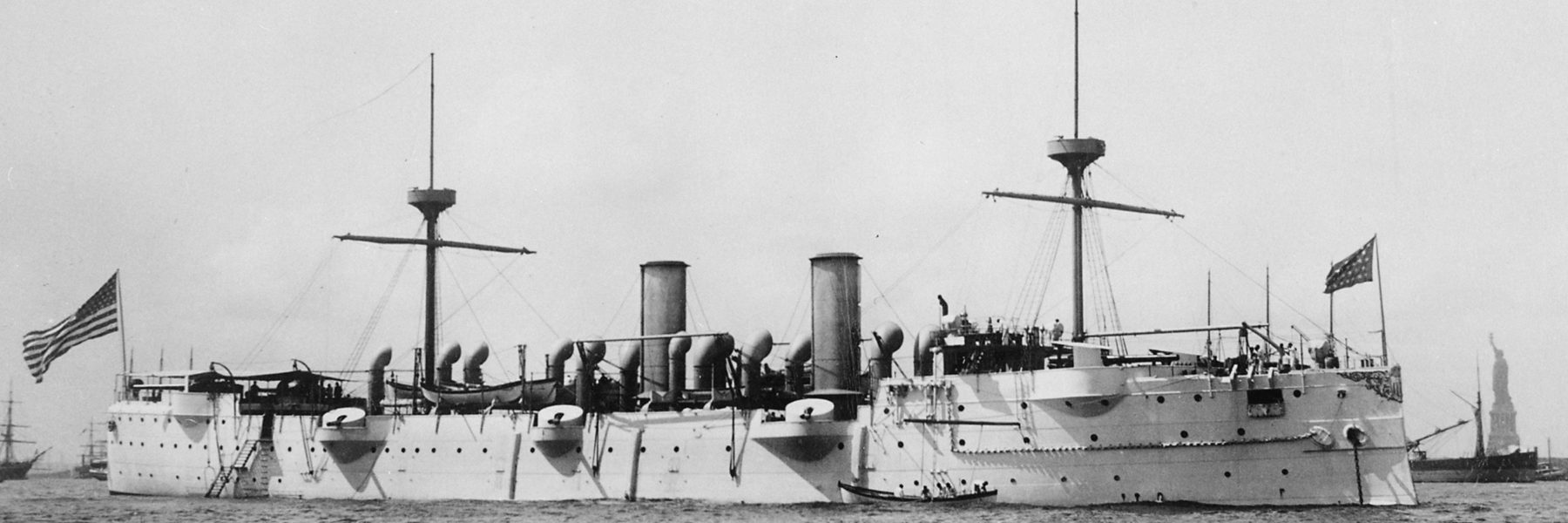
The old cruisers USS Baltimore (completed in 1890) and USS Philadelphia (1890), were excellent ships built at Cramp on an English design (Eltswick). They served during the Spanish American War of 1898 but were quickly put to sleep from 1904, the Philadelphia becoming a barracks ship at Puget Sound and the Baltimore at Charleston from 1911. The USS Baltimore was quickly converted into a minesweeper and participated in the naval operations of 1917, with armament reduced to 4 pieces of 100 mm and two batteries of 76 mm AA. It was not removed from the lists until 1922 and returned to its role as a barracks ship which she held until 1942, when it was sold for demolition. A great 52-year career.
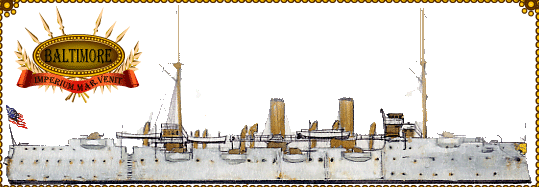

Author’s illustrations of USS Baltimore as built and in 1914
Specifications
Displacement: 4413t, 5436t FL
Dimensions: 102,11 x 14,78 x 5,94m
Propulsion: 2 shafts, 4 boilers VTE engines 10,750 hp. 19 knots
crew: 386
Armament: 4 x 203 mm, 6 x 152 mm, 4 x 75 mm, 2 x 47, 2 x 37 mm.
USS Philadelphia
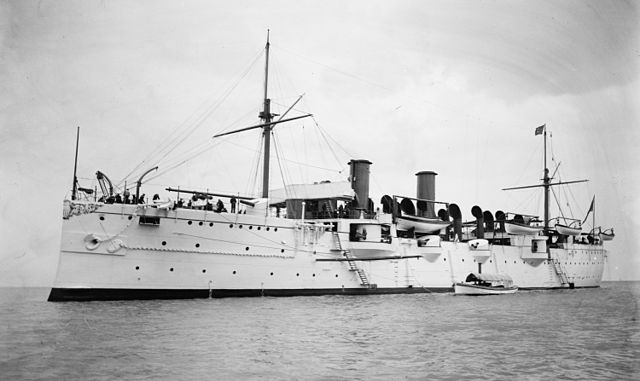
Authorized in 1887, USS Philadelphia she was rigged as three-mast schooner, without head gear and generally similar to the USS Baltimore in protection notably. The armament and armour scheme as also remarkably similar to the two ships are even classed as sister-ships. Built at Cramp in 1888-89 and completed in July 1890, USS Philadelphia was sent to Puget sound in 1902 for extensive repairs and in 1904 housed over as receiving ship at the same yard, remaining as such with a small period as prison ship until 1926.
Specifications
Displacement: 4324/5303t
Dimensions: 102.11 x 14,78 x 5.84m
Propulsion: 2 shafts HTE, 4 cyl boilers, 9000 ihp. 19 knots (1031 tonnes coal).
Crew: 384
Armament: 16 x 6-in, 4 x 3-pdr, 2 x 1-pdr.
USS San Francisco
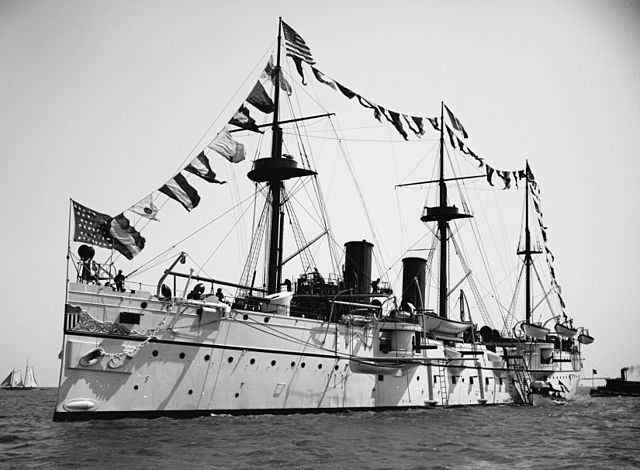
Authorized in 1887, USS San Francisco (C5) was built at Union Iron Works, in the same name city. She was a near-repeat of USS Newark, rigged as a three masted schooner without head gear, and with a main armament of 6-in guns with a different management, 16 in all. After modernization, in 1902 she gained longer, faster 6-in/40 guns and new babcock and wilcox boilers. Like the previous ships she reached 19 knots. Four of the 6-in were mounted on decks fore and aft and not in sponsons. She had a 2-in/3-in sloped protective deck, 3-in CT. Launched in October 1889 and completed in November 1890. USS San Francisco was converted in 1908 as a minelayer, and in 1917 she participated in the laying of the great northern mine barrage. In 1918 her armament was reduced to four 5-in guns/51 and in 1921 she was placed in reserved in Philadelphia, remaining in reserve until 1937, renamed Tahoe and Yosemite in 1930, but kept in reserved until sold in 1939. So she saw three conflicts (1898, WW1 and WW2).
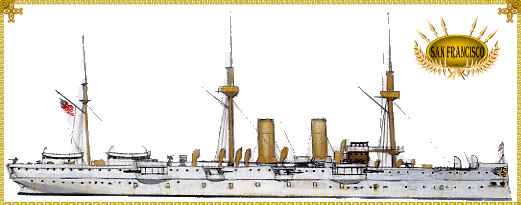
Author’s illustration, as built
Specifications
Displacement: 4088/4583 tonnes
Dimensions: 98.91 x 14,98 x 5.74m
Propulsion 2 shafts HTE, 4 cyl boilers, 10,500 shp. 19 knots.
Crew: 384
Armament: 12 x 6-in, 4 x 6pdr, 2 x 1pdr.
American Protected Cruisers
USS Olympia (1892)
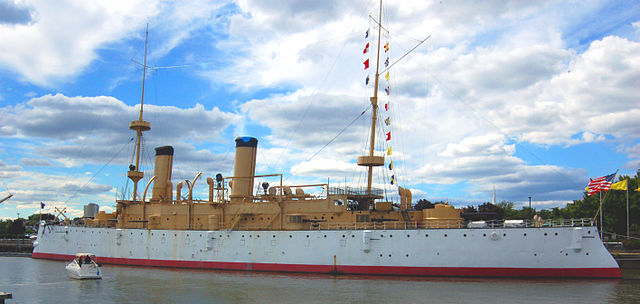
USS Olympia as preserved today in Philadelphia
The cruiser USS Olympia was the most famous of the 1898 war, as she was the flagship of Commodore Dewey, the Hero of the battle of Manilla. She was relatively fast but small and cramped, and not seriously tested during the battle. Authorized in 1888, built at Union Iron Works in 1891-92 and commissioned in 1895, USS Olympia was brand new when the war erupted. Protection was assured by 3,5 to 4,5in Harvey nickel steele plates, which would have been probably not sufficient against some spanish ships. However the engines room was well protected by a 4in glacis. She was a good steamer, capable of 17 300 hp on forced draught, giving 21,7 knots. She is now the only preserved warship of this kind in the world, and can be seen in the Independence Seaport Museum, philadelphia PA.

Author’s illustration, as built
Specifications
Displacement: 5862 t (6558 t FL)
Dimensions: 104,78 x 16,15 x 6,55 m
Propulsion: 2 shafts VTE, 6 cyl Boilers, 13 5000 hp, 20 knots.
Armour: Harvey belt 3 in, barbettes 4,5 in, turrets 3,5 in, secondary 4 in, CT 5 in
Armament: 4x 8in (203 mm), 10x 5in (127 mm), 14x 6pdr (57 mm), 6x 1pdr (37 mm QF) 6x 457 mm aw.
Crew: 411
Cincinatti class (1892)
USS Cincinatti, Raleigh
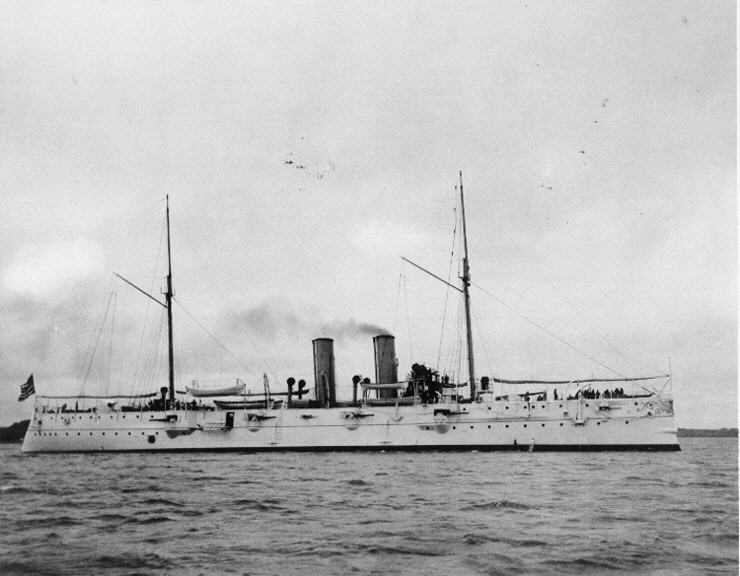
USS Cincinnati (C7) as built
Authorized in 1888, these two cruisers were loosely based on the classic Armstrong-Elswick style export cruiser. But they had a single 6 inches gun and her 5in were not as efficient. Commissioned in 1895, they played no active part in 1898 battles. These two small and relatively fast cruisers built in NY navy yard and Norfolk were originally rigged but their fore and aft sails were removed in 1899.
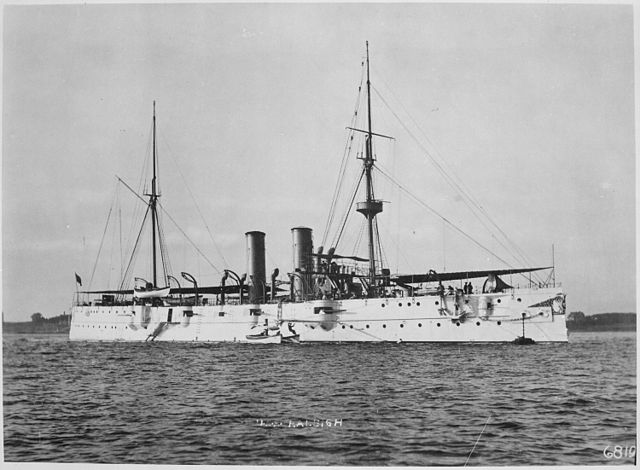
USS Raleigh, starboard view circa 1900
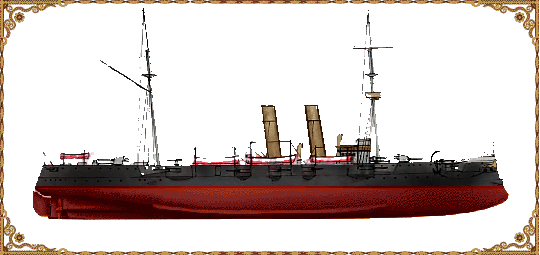
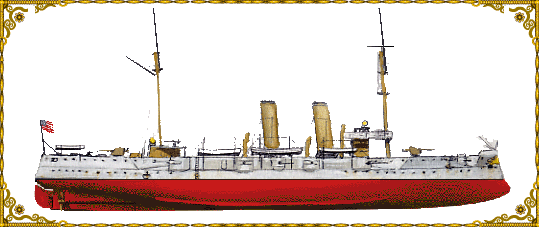
Author’s rendition of the USS Cincinnati and Raleigh prior to the 1898 war
Specifications
Displacement: 3183 t (3339 t FL)
Dimensions: 93,13 x 12,80 x 5,49 m
Propulsion: 2 shafts VTE, 6 cyl Boilers, 10 000 hp, 19 knots.
Armour: Complete 2in and 2,5in amidship protective deck, CT 2in
Armament: One 6in/30 (152 mm), 10 x 5in (127 mm), 8 x 6 pdr (75 mm), 2 x 1pdr (37 mm) QF guns, four 457 mm TT sub
Crew : 322
Montgomery class (1891)
USS Montgomery, Detroit, Marblehead
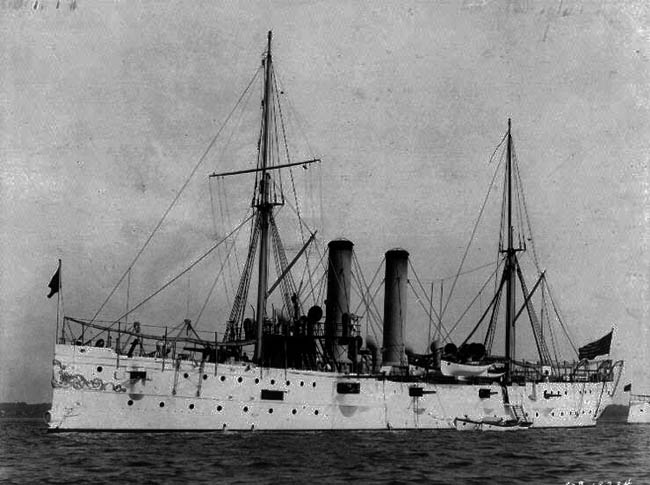
USS Montgomery, Detroit and Marblehead were ordered in 1888 and commissioned in 1893-94. They were of questionable military value, slow, poorly armed and unprotected. They were not involved in the war against Spain, and the USS Detroit was struck off the lists in 1910, while the USS Montegomery had served as an experimental torpedo boat since 1908. It participated like the Marblehead in the Great War and was disarmed in 1919, the other in 1921.
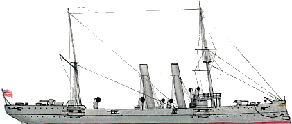
Specifications
Displacement: 2094/2235 tonnes
Dimensions: 82.14 x 11,27 x 4.44m
Propulsion 2 shafts VTE, 6 cyl boilers, 4500 ihp. 17 knots.
Crew: 274
Armament: 9 x 5in/40 (127 mm), 6 x 6-pdr (47 mm), 2 x 1-pdr (37 mm), 3 x 18-in TT aw.
Columbia class (1893)
USS Columbia, Minneapolis
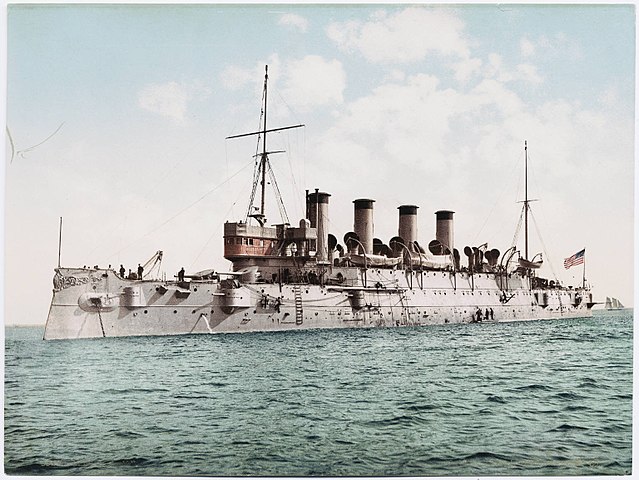
USS Columbia, Detroit Photographic Company (cc)
USS Columbia and Minneapolis were certainly the most striking US cruisers of that era. At a time great powers from Europe had a tremendous maritime traffic, both ships has been designed as commerce raiders. Authorized under the act of June 1890 and 1891 they also differed between themselved in appearance, having two or four funnels according to their machinery. At 126 meters long by 17.72 they were relatively nimble and fast, but lightly armed to such a package, with only one heavy guns (8-in) and tw medium (6-in). The first was on the deck forward, centerline, the latter were aft behind the superstructure either side of the deck. The rest comprised an array of 5-in in sponsons, 6-pdr and 1-pdr plus four surface torpedo tubes, either of 14-in (for civilian vessels) or 18-in.
The sponsons guns and walls were protected by 4-in, the CT had 5-in walls, the protective deck was 2-1/2 inches thock with 4-in slopes. Both ships missed the 1898 war. Both were out of commission from 1907 and 1906 respectively, robably due to their high operating cost and coal consumption, although they had been recoignise good walkers. Indeed USS Columbia beat SMS Fürst Bismarck in 1895, rallying in six days 23 hours 49 minutes Sandy Hook from Southampton.
They were recommissioned in 1915 and 1917.
Both escorted convoys during the war and in 1919, their forward 8-in was removed and replaced by a third axial 6-in/40 while four 4-in/40 were added as well as two 3-in AA (76 mm) and the TTs removed.
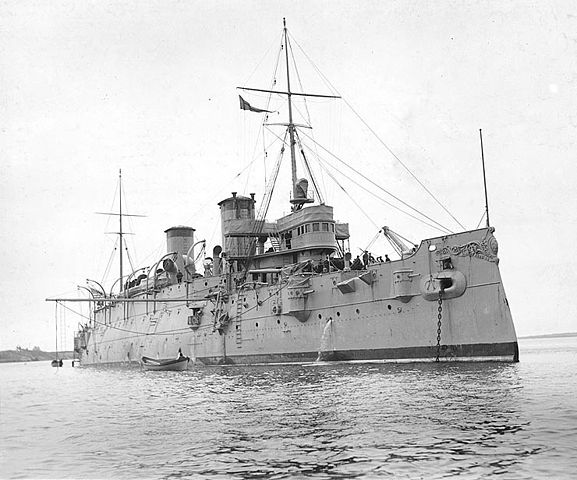
USS Minneapolis


USS Columbia as built and in 1917
Specifications
Displacement: 7375/8270 tonnes FL
Dimensions: 125.90 x 17.72 x 6.88m
Propulsion 2 shafts VTE, 8 Babcock et Wilcox boilers, 21,000 shp. 21 knots, coal 1670 tonnes wt
Crew: 477
Armament: 1 x 8(in, 2 x 6-in, 8 x 4-in, 12 x 6-pdr, 4 x 1-pdr, 4 TTs aw, see notes
New Orleans class (1896)
USS New Orleans, Albany
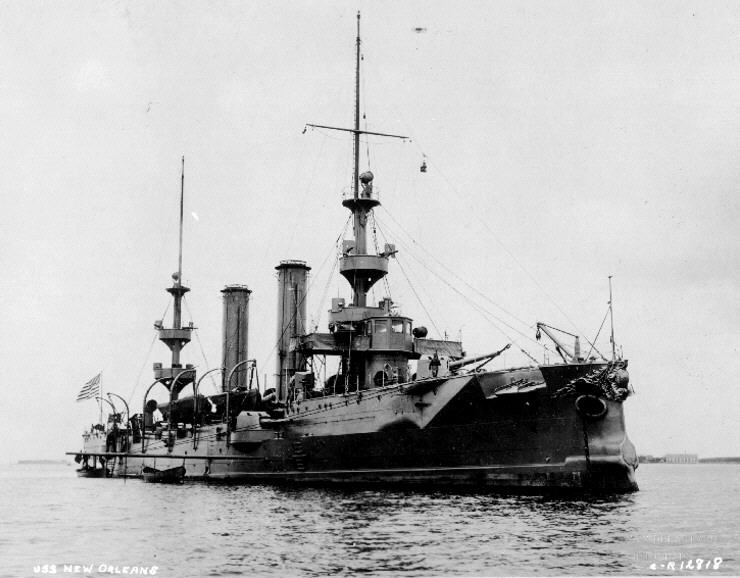
USS New Orleans
Both ships had an interesting story. These were previously British-built protected cruisers interned for the Brazilian Navy, by Armstrong Elswick, typical Elswick cruisers. Although both ships would have been named Zenteno and Barroso (part of an order for four), and already fitting out, they were purchased by the US Government, desperate to bolstered its cruiser fleet before going to war with Spain in 1898. USS New Orleans had been just completed on 18 March 1898, when she had been purchased on 9 March. The second was completed in May 1900 and they were renamed USS New Orleans and Albany respectively. They had six 6-in guns installed on the forecastle deck and poop, the other four in side sponsons with hull recesses to fire forward or aft at 90° respectively.
These were US-manufactured 6-in/50 Mark V EOC DD (152 mm), under armoured masks. This was completed by four 4.7 in/50 EOC AA (120 mm), behind shields on the broadside, ten 6-pdr and eight 1-pdr, the latter installed in the fighting tops, four in all on both masts. Both ships had modern VTE machinery mated on four cyl boilers, two shafts, rated for 7,500 ihp, enough for 20 knots as contracted by the Brazilians. They could carry 747 tonnes of coal in wartime. Good walkers they were protected by an armoured deck 1-1/4 inches thick with 3-1/2 inches slopes. There was a 4-in boiler room glacis for extra protection and the conning tower walls were also 4-in thick. Eventually USS New Orlans stayed in home waters during the war.
In 1907, both were rearmed with a more uniform battery of ten 5-in/50 guns and later this was reduced to eight, and the TTs were removed. They had a long and varied service and overall, recoignised as good (and cheap) acquisitions for the USN as well as a sneak peak into the latest British naval engineering gigs. Both were decommissioned in 1922 as for the Washington treaty, but kept in reserve until sold in 1930.
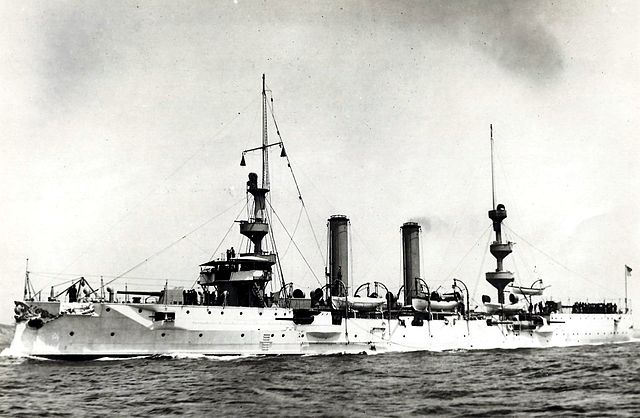
USS Albany

Author’s rendition of the New Orelans class
Specifications
Displacement: 3769t, 4011t FL
Dimensions: 108.03 x 13,33 x 5.49m
Propulsion 2 shafts VTE 4 cyl Babcock et Wilcox boilers, 7500 ihp. 20 knots.
Crew: 366
Armament: 6 x 152 mm, 4 x 120 mm, 10 x 76mm , 8 x 37 mm, 3 457 mm TTs.
Denver class (1902)
USS Denver, Des Moines, Chattanooga, Galveston, Tacoma, Cleveland.
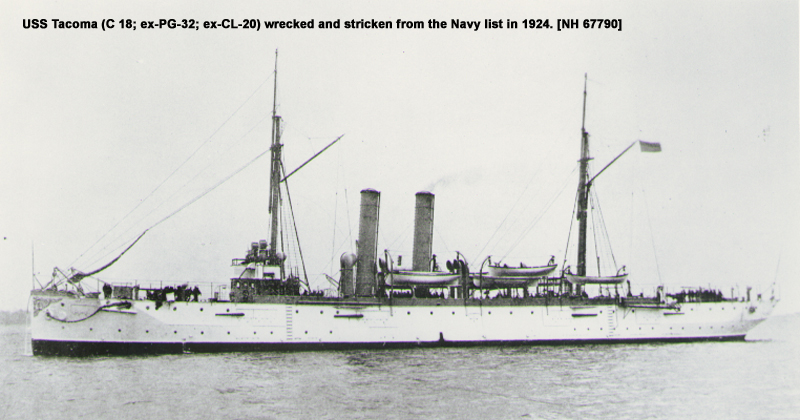
These six cruisers were authorized by Congress in 1899, as part of the naval buildup following the Spanish–American War. It was specified cruisers that can act in peacetime as gunboats in foreign stations and tropical climates. Of course, Cuba and the Philippines, newly acquired, were the first concerned. Their armament and speed was indeed efficient for the to take part in fleet duties, so they were more “station gunboats” than cruisers. They were cheap, of simple design with a flush deck hull, tall masts (with a schooner rigging) and tall funnels. The rigging was actually never mounted, as the ships, built at Neafie & Levy, Fore River, Crescent, WR Trigg, Union Iron Works and Bath Iron works, were all laid down in January to August 1900 (but USS Galveston, 1901), launched in 1901-1903 and commissioned in 1903-1905, had their deck 6-in guns under masks mounted forre and aft on the deck, the others in sponsons and two in hull recesses, as their eight 6-pdr and two 1-pdr higher up in the bridge forward. The casemates were protected by 1-1/4 inches plates, with a ptorective deck with 1 in flat and 2-1/2 in slopes. They had a quiet career, patrolling home waters during WW1, and only USS Tacoma was lost, short before retirement in 1924, wrecked on the Blaquilla reef off Vera Cruz. They were all sold in 1930.
Specifications
Displacement: 3200/3514t
Dimensions: 94.13 x 13,41 x 4.8m
Propulsion 2 shafts VTE, 6 Babcock and Wilcox boilers, 4,500 shp. 16.5 knots.
Crew: 339
Armament: 10 x 5 in/50 Mk 5 (127 mm), 8 x 6-pdr (47mm), 2 x 1-pdr (37 mm).
Chester class (1907)
USS Chester, Birmingham, Salem.
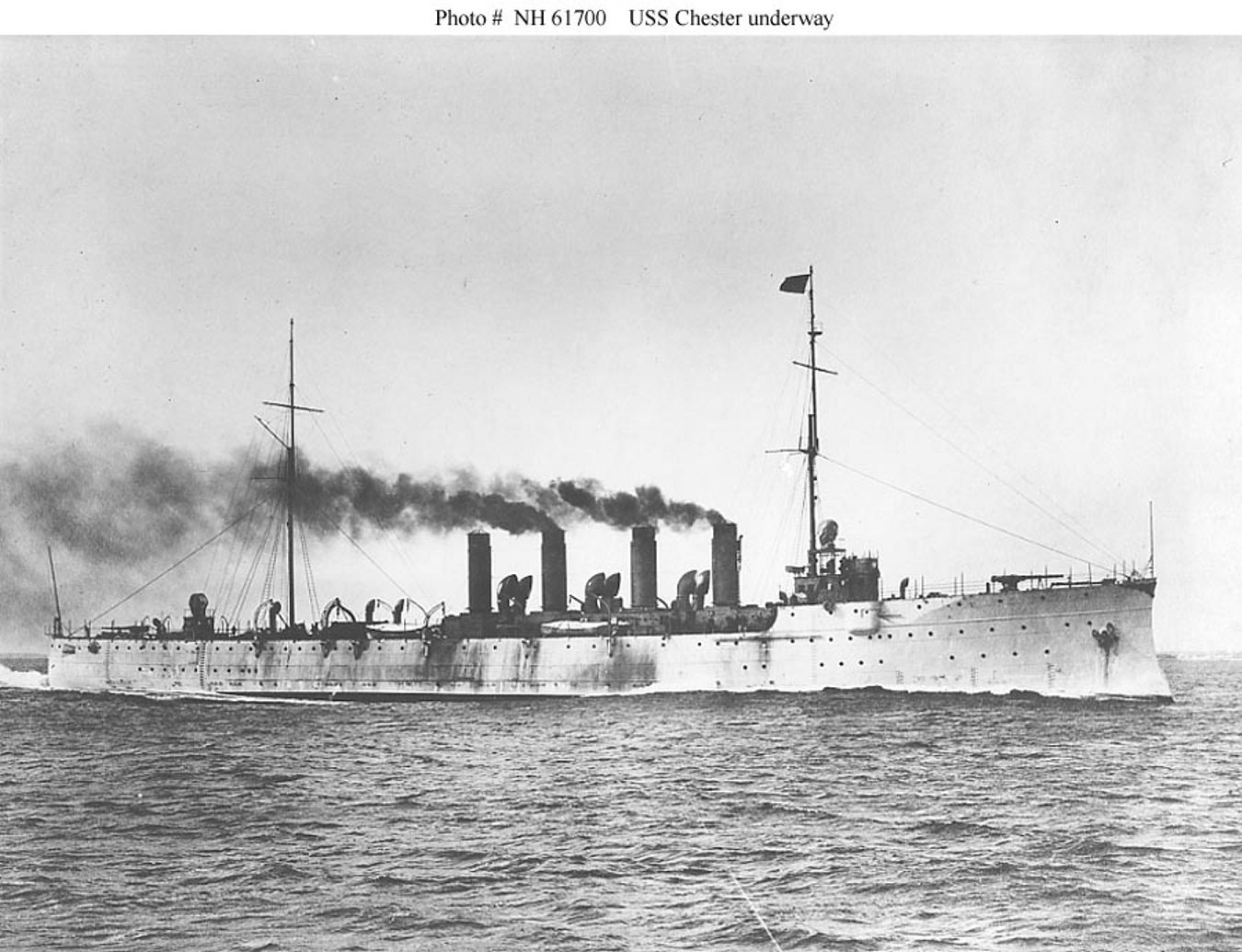
The Chester class ships, USS Chester, Birmingham and Salem, completed in 1908, were the last American cruisers before the Omaha class in 1922. They were also the first American cruisers to have turbines. They were designed to be scouts, and much had been done for their lightness and speed. With 24 knots indeed, they were the fastest cruisers in the fleet.
Lightly armed, they nevertheless actively participated in the First World War. The Birmingham made the world’s first attempt to take off an airplane from a platform on its foredeck. Lieutenant Eugene Ely made history on his Curtiss at Hampton Road in 1910. The three units were finally retired from service in 1921 and 1923, and sold for demolition in 1930.
Specifications
Displacement: 3750t, 4700t FL
Dimensions: 129 x 14,34 x 5,10m
Propulsion: 2 shafts Parsons/Curtis Turbines, 12 Normand/Fore River boilers 16,000 hp. 24 knots.
Crew: 360
Armament: 2 x 127 mm, 6 x 76 mm, 2 533mm TTs.
American Armoured Cruisers
USS New York/Saratoga (1891)
USS New York was the first American armored cruiser. She was renamed USS Saratoga in 1911 with the construction of the Dreadnought USS New York. She fought during the war against Spain in 1898, then served during the Great War by escorting convoys. In December 1911 she has been renamed USS Rochester and she kept this name for long years. In 1927 4 boilers and two funnels were removed, but she continued to serve until 1933, notably in the Philippines since 1930, being finally struck off the lists and put in reserve, on site, in 1938. In December 1941 it was decided to scuttle her to avoid her capture by Japanese troops.

Specifications
Displacement: 8200 tonnes/9021 fully loaded
Dimensions: 117 x 19.76 m (384 x 64 feets, 1/5 ratio)
Propulsion: 2 shafts VTE, 8 boilers, 16,000 hp 20 knots max.
Armor: Belt shield, Barbettes, turrets, blockhouse
Armament: 6 x 8-in/35 (203 mm)m, 12 x 4in/40, 6 x 6-pdr, 2 x 1-pdr.
Crew: 380
USS Brooklyn (1895)
Recognizable by her three huge funnels, USS Brooklyn was built in Cramp NyD, completed in 1896. The influence of French design was seen in the pear-shaped section, and with a main diamond style turret arrangement for the main armament and flared sides. Admiral Schley’s flagship at the Battle of Santiago in 1898, she was not hit by any Spanish shell, fortunately for the crew, because her protection was weak for an armoured cruiser. She was placed in reserve from 1908 to 1914 but resumed service during the war, then was fully rearmed in 1919, loosing four 5-in guns and gaining two 3-in AA. In 1920 she was assigned to the Pacific squadron, struck from the lists and sold in 1921. See the article for more.

Specifications
Displacement: 9,215t, 10,070t PC
Dimensions: 122,7 x 19,7 x 5,32m
Propulsion: 2 shafts VTE, 7 boilers, 16,000 hp. 20 knots.
Armament: 8 x 203 (4×2), 12 x 127, 12 x 47mm, 4 x 37, 5 TT 457mm.
crew: 580
Pittsburgh (Pennsylvania) class (1903)
USS Pennsylvania, West Virginia, California, Colorado, Maryland, South Dakota
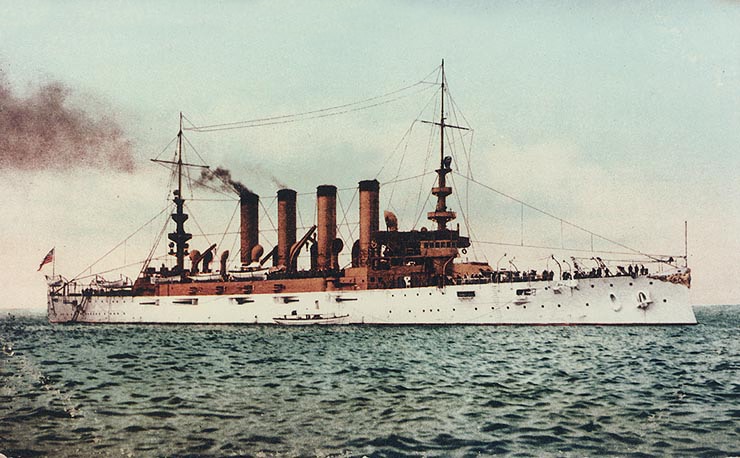
The Pennsylvania-class armoured cruisers were launched in 1903-1904, and renamed between 1912 and 1920 Pittsburgh, Huntington, San Diego, Pueblo, Frederick, Huron, in order to leave these names free for the dreadnoughts then planned. They were part of the naval buildup touched off by the Spanish–American War. Together with the newt four Tennessee-class, they formed the “Big Ten”, originally intended to take place in a battle line as was the case in other navies. The dreadnought rendered them obsolete overnight. Their role changed after entering service due to the Russo-Japanese War and the doctrine change of 1906, focusing the US Navy’s battleships in the Atlantic, while the armoured cruisers took their place in the Asiatic Fleet and Philippines to counter Japan. By 1912, they were found without really use in the Navy.
When WW1 broke out, these ships patrolled Latin America and the Western Pacific until 1917, and they acted as convoy escorts until the end of the war, repatriating troops in 1919. USS Pittsburg was the only one in the “big ten” operating in the Pacific, trying to catch German commerce raiders. They were kept in reserve or reduced to menial tasks until 1930, then sold, according to the London treaty global cruiser tonnage limitations.

Author’s illustration of USS Pittsburg in 1917
Specifications
Displacement: 13,680t – 15,138t FL
Dimensions: 153,58 x 21,20 x 7,34 m
Propulsion: 2 shafts, 16 Babcock and Wilcox boilers, 23,000 shp. 22 knots max.
Armor: Belt shield, Barbettes, turrets, blockhouse
Armament: 2×2 203mm, 14 x 152 mm, 18 x 76mm, 12 of 47 mm, 2 x 37 mm, 1x 457mm TTs
Crew: 198
Saint Louis class (1904)
USS St Louis, Milwaukee, Charleston
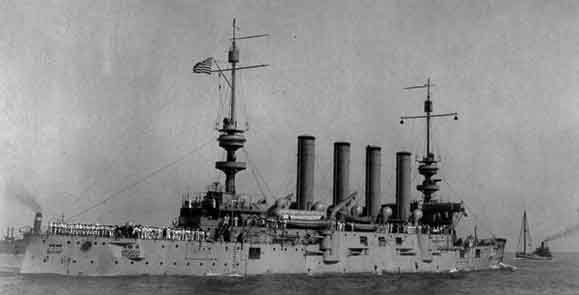
USS Saint Louis (C20)
The Saint Louis class heavy cruisers, launched in 1904-1905, were of an intermediate type, in between a protected and an armoured cruiser, less expensive than those of the Pittsburg class. Their design was generally considered less successful however. The class included only three ships, USS Saint Louis, the Milwaukee and Charleston. USS Milwaukee was lost in 1917 hitting a reef while trying to save the crew of the H3 submersible on the Californian coast and her wreck broke in two during a storm in 1918. The other two escorted convoys in the Atlantic and were planed in reserve and sold in 1930.

Author’s illustration of the St. Louis class
Specifications
Displacement: 9,700t standard, 10,840t FL
Dimensions: 129.91 x 20.12 x 6.86m
Propulsion: 2 shafts VTE, 16 Babcock and Wilcox boilers 21000 shp. 21 knots.
Armor: Belt, Barbettes, turrets, blockhouse
Armament: 14 x 152 mm, 18 x 76 mm, 12 x 47 mm, 8 x 37 mm.
Crew: 673/767
Memphis (Tennesse) class (1904)
USS Tennessee, Washington, North Carolina, Montana
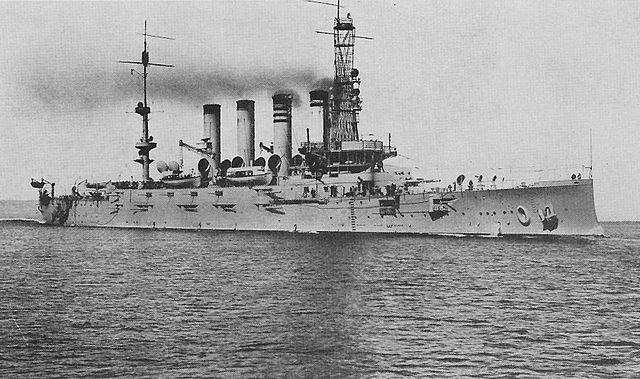
USS Montana in 1915 (ACR15)
The Tennesse-class armiured cruisers included the USS Tennesse, Washington, North Carolina and Montana, launched in 1904-1906, and renamed in 1916 and 1920, to free named for new dreadnoughts in construction: They became USS memphis, Seattle, Charlotte and Missoula. They were true copies of the Pennsylvania, except that their displacement was greater, and their armament arguably more powerful. The Memphis, ex-tennessee, received like the others a basket type main mast in 1911 and actively participated in the great war. She was sunk by an exceptionally tall Tsunami in 1916. USS Seattle survived in various roles until 1946.

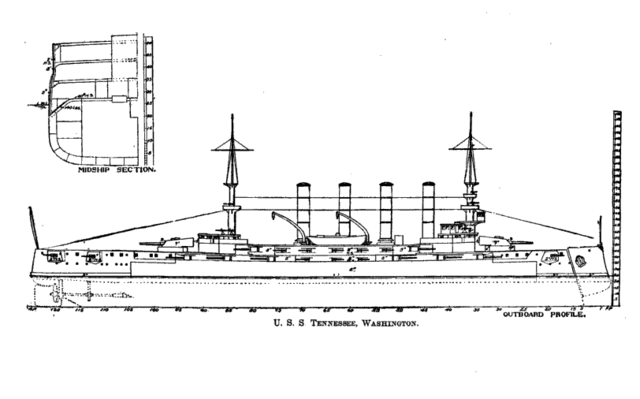
Specifications
Displacement: 14,500 t, 15,715 t FL
Dimensions: 153.76 x 22.23 x 7.6m
Propulsion: 2 shafts VTE, 16 Babcock and Wilcox boilers 23,000 shp 22 knots.
Armour: Belt 5 in, Barbettes 8 in, Turrets 9 in
Armament: 4 x 254, 16 x 152, 22 x 76, 12 x 47, 2 x 37 mm, 4 x 533mm TTs.
Crew: 860
WW1 Cruisers: The Omaha class
USS Omaha, Milwaukee, Cincinnati, Raleigh, Detroit, Richmond, Concord, Trenton, Marblehead, Memphis
The Omaha were the first American cruisers built after a long vacancy in 1905 (order of the Chester). Originally designed in 1919, their program dated back to 1915, but a proposal was first rejected in 1917, then accepted by the Congress in 1918. They were pure scouts, doubling as flotilla leaders for the new large fleet destroyers in construction at the same time (Wickes and Clemson classes). They even resembled them, typically flush-deck and with four funnels.
Their artillery was quite original combining for the first time twin turrets fore and aft and barbettes. To to their late order, none was even laid down when the war ended (the first in december). They were launched in 1920-23 and completed in 1922-24, missing the war entirely but becoming the first interwar and last pre-Washington-treaty cruisers.
Nedless to say their construction was very lightly, like scaled up destroyers thay had a 1/10 ratio, and were quite powerful, using for the first time a set of turbines, giving them almost 100,000 shp, whereas the last armoured cruisers, nearly 15,000 tonnes, only had a thord of this output. In service however, they were very “wet” in heavy weather common in the North Atlantic. They gained a poor reputation during WW2 when escorting co,voys, notably in the dreaded Murmansk road. They had a long career, receiving modern AA and radars, and soldiered on for the duration of WW2, earning many battle honors in the process.
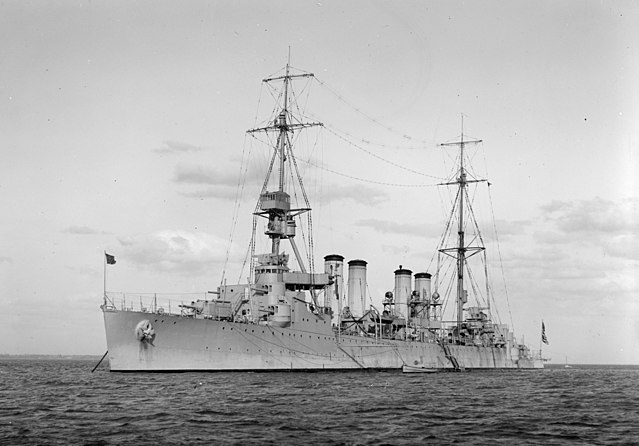
USS Memphis in Australian waters in the 1920s
Specifications
Displacement: 7,050 t, 9,508 t FL
Dimensions: 169.40 x 16.9 x 4.1m
Propulsion: 4 shafts Westinghouse turbines, 90,000 shp, 34 knots.
Armour: Belt 3 in (76 mm,) armored deck 1-1/2 in (38 mm)
Armament: 12 x 6in/53 (152mm), 2 x 3-in AA (76mm) 2×3+ 2×2 21-in (533mm) TTs.
Crew: 860


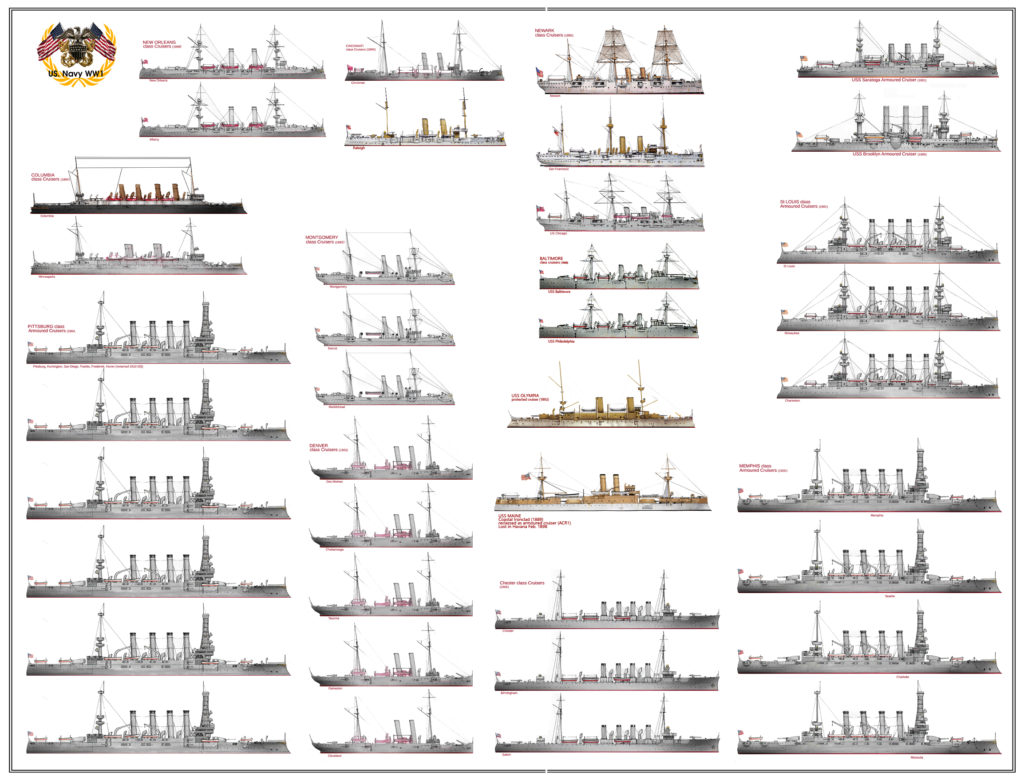
 Latest Facebook Entry -
Latest Facebook Entry -  X(Tweeter) Naval Encyclopedia's deck archive
X(Tweeter) Naval Encyclopedia's deck archive Instagram (@navalencyc)
Instagram (@navalencyc)





 French Navy
French Navy Royal Navy
Royal Navy Russian Navy
Russian Navy Armada Espanola
Armada Espanola Austrian Navy
Austrian Navy K.u.K. Kriegsmarine
K.u.K. Kriegsmarine Dansk Marine
Dansk Marine Nautiko Hellenon
Nautiko Hellenon Koninklije Marine 1870
Koninklije Marine 1870 Marinha do Brasil
Marinha do Brasil Osmanlı Donanması
Osmanlı Donanması Marina Do Peru
Marina Do Peru Marinha do Portugal
Marinha do Portugal Regia Marina 1870
Regia Marina 1870 Nihhon Kaigun 1870
Nihhon Kaigun 1870 Preußische Marine 1870
Preußische Marine 1870 Russkiy Flot 1870
Russkiy Flot 1870 Svenska marinen
Svenska marinen Søværnet
Søværnet Union Navy
Union Navy Confederate Navy
Confederate Navy Armada de Argentina
Armada de Argentina Imperial Chinese Navy
Imperial Chinese Navy Marinha do Portugal
Marinha do Portugal Mexico
Mexico Kaiserliche Marine
Kaiserliche Marine 1898 US Navy
1898 US Navy Sovietskiy Flot
Sovietskiy Flot Royal Canadian Navy
Royal Canadian Navy Royal Australian Navy
Royal Australian Navy RNZN Fleet
RNZN Fleet Chinese Navy 1937
Chinese Navy 1937 Kriegsmarine
Kriegsmarine Chilean Navy
Chilean Navy Danish Navy
Danish Navy Finnish Navy
Finnish Navy Hellenic Navy
Hellenic Navy Polish Navy
Polish Navy Romanian Navy
Romanian Navy Turkish Navy
Turkish Navy Royal Yugoslav Navy
Royal Yugoslav Navy Royal Thai Navy
Royal Thai Navy Minor Navies
Minor Navies Albania
Albania Austria
Austria Belgium
Belgium Columbia
Columbia Costa Rica
Costa Rica Cuba
Cuba Czechoslovakia
Czechoslovakia Dominican Republic
Dominican Republic Haiti
Haiti Hungary
Hungary Honduras
Honduras Estonia
Estonia Iceland
Iceland Eire
Eire Equador
Equador Iran
Iran Iraq
Iraq Latvia
Latvia Liberia
Liberia Lithuania
Lithuania Mandchukuo
Mandchukuo Morocco
Morocco Nicaragua
Nicaragua Persia
Persia San Salvador
San Salvador Sarawak
Sarawak Uruguay
Uruguay Venezuela
Venezuela Zanzibar
Zanzibar Warsaw Pact Navies
Warsaw Pact Navies Bulgaria
Bulgaria Hungary
Hungary

 Bundesmarine
Bundesmarine Dutch Navy
Dutch Navy Hellenic Navy
Hellenic Navy Marina Militare
Marina Militare Yugoslav Navy
Yugoslav Navy Chinese Navy
Chinese Navy Indian Navy
Indian Navy Indonesian Navy
Indonesian Navy JMSDF
JMSDF North Korean Navy
North Korean Navy Pakistani Navy
Pakistani Navy Philippines Navy
Philippines Navy ROKN
ROKN Rep. of Singapore Navy
Rep. of Singapore Navy Taiwanese Navy
Taiwanese Navy IDF Navy
IDF Navy Saudi Navy
Saudi Navy Royal New Zealand Navy
Royal New Zealand Navy Egyptian Navy
Egyptian Navy South African Navy
South African Navy






























 Ukrainian Navy
Ukrainian Navy dbodesign
dbodesign